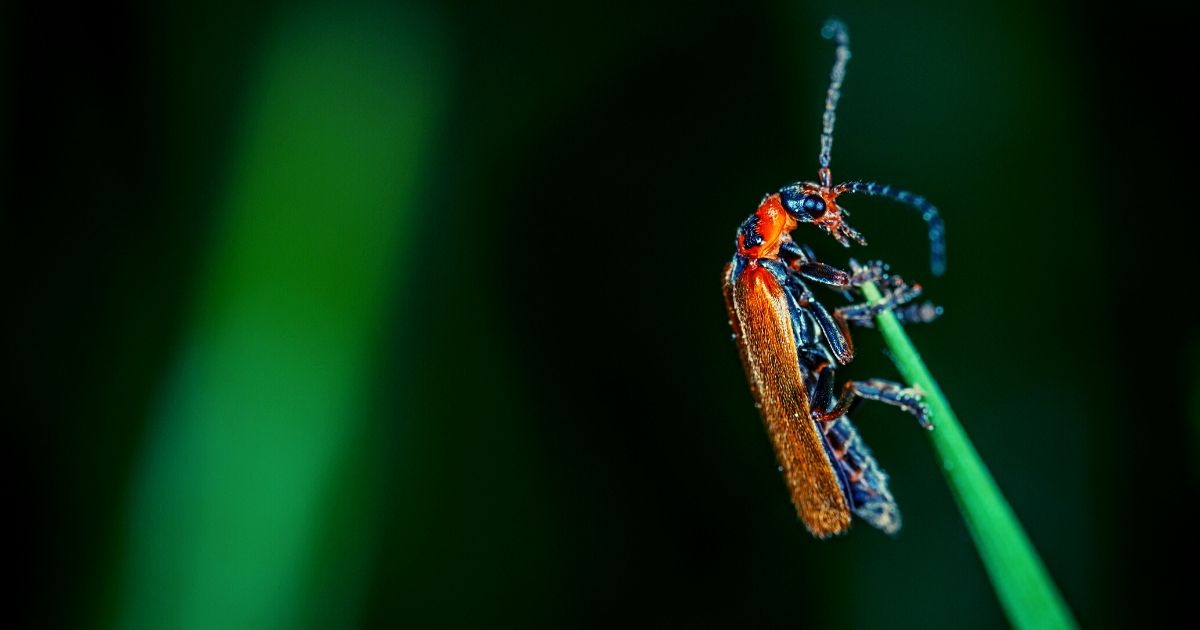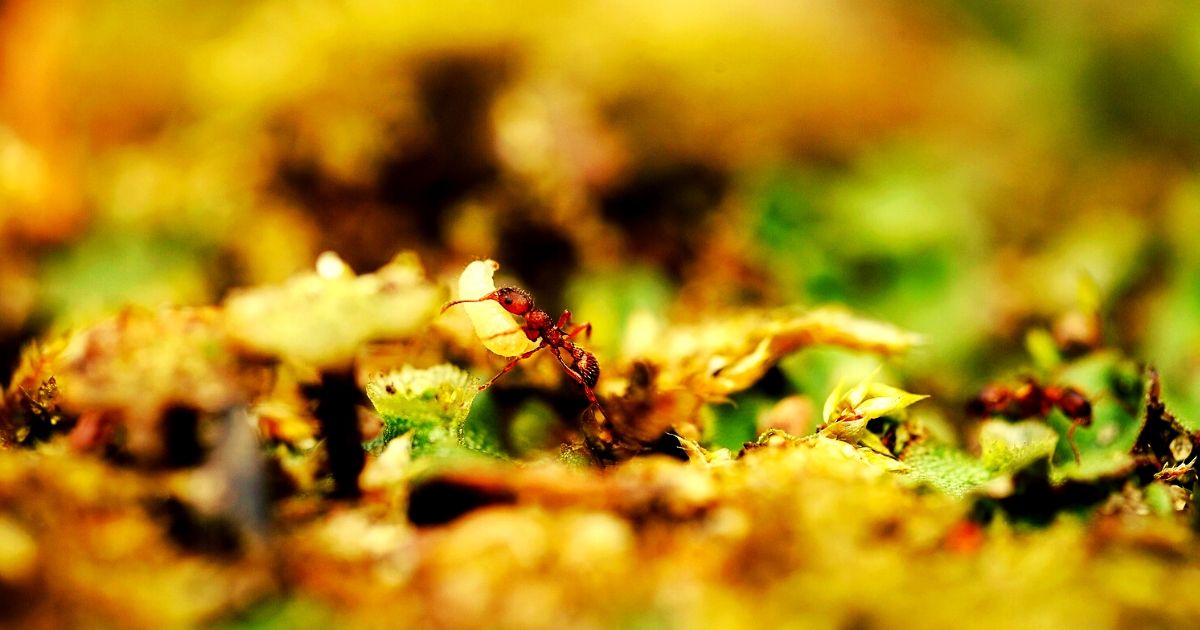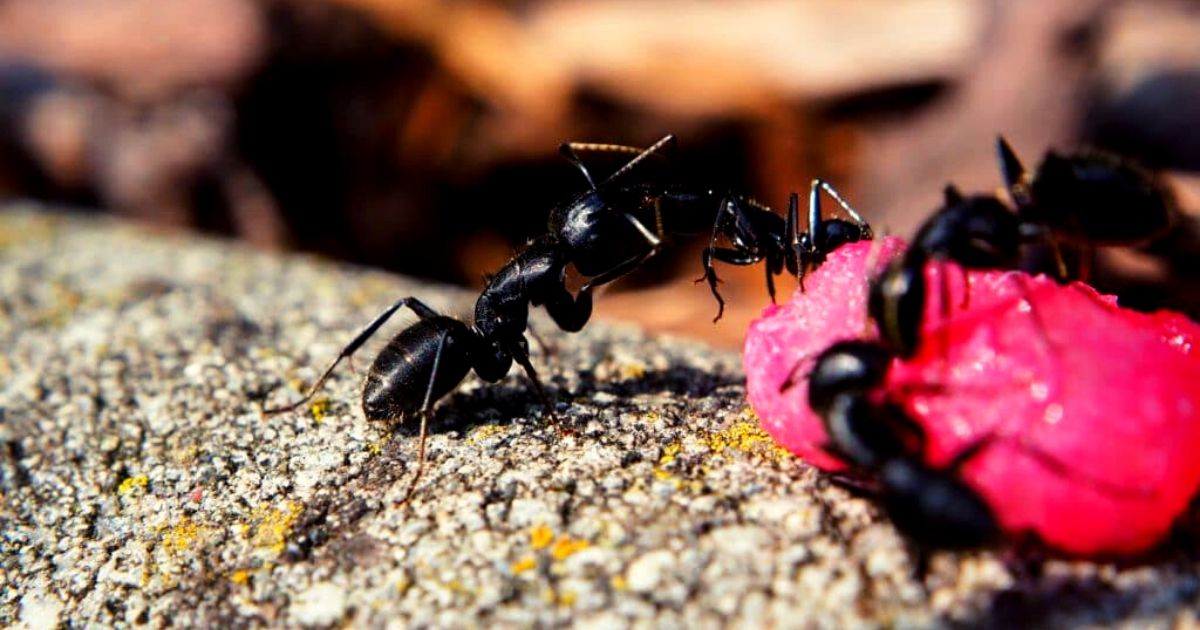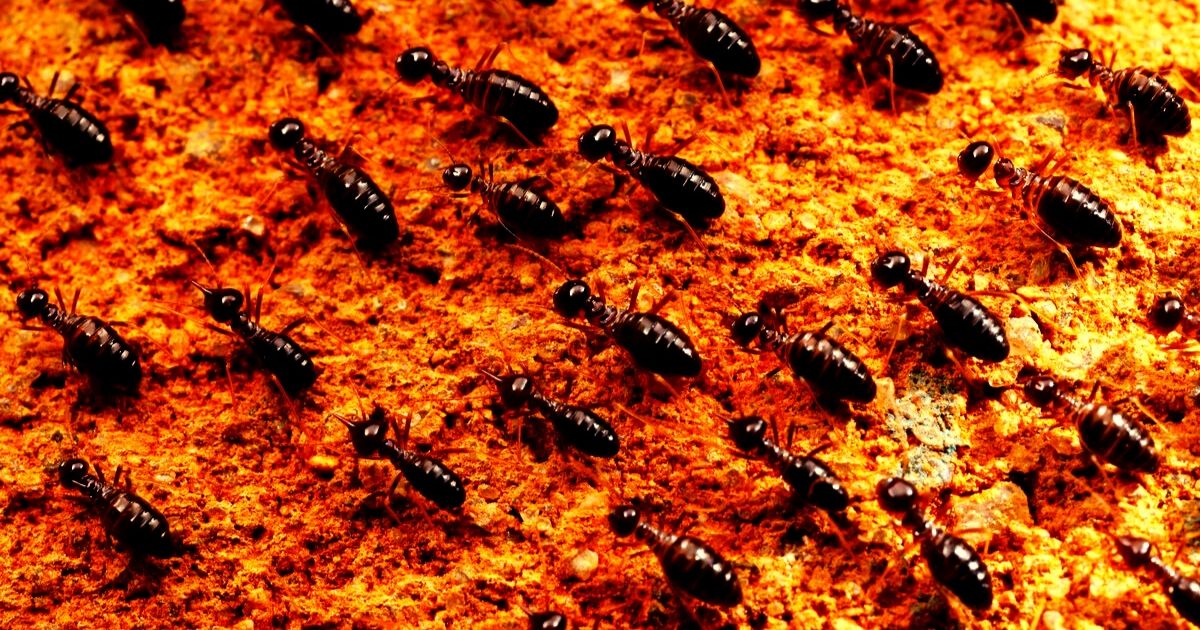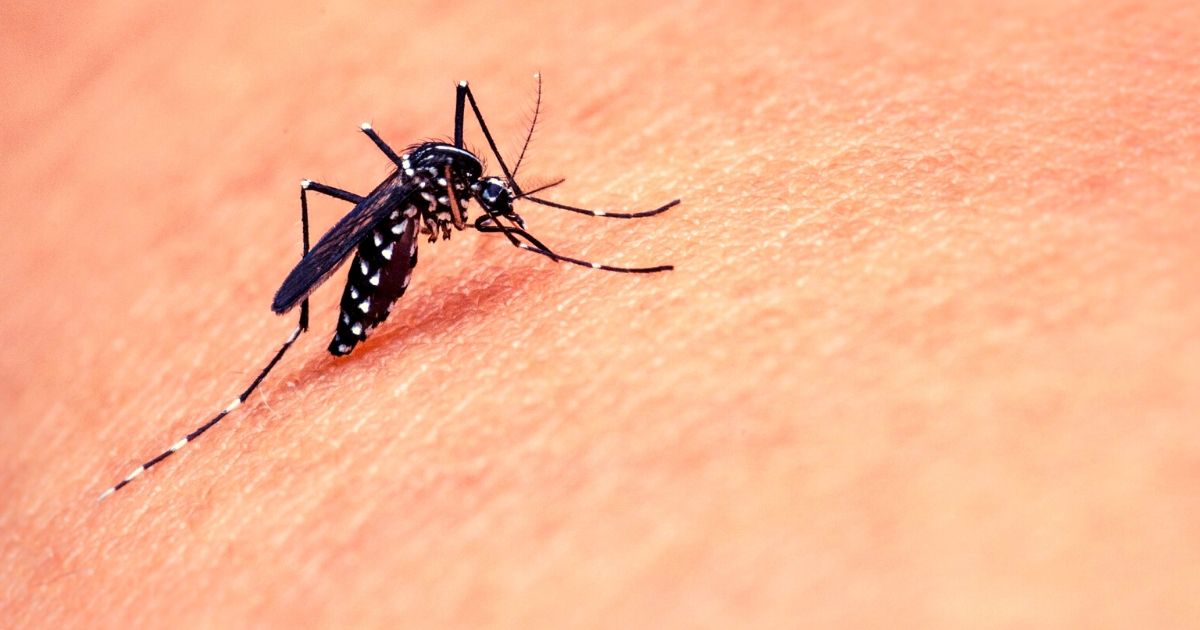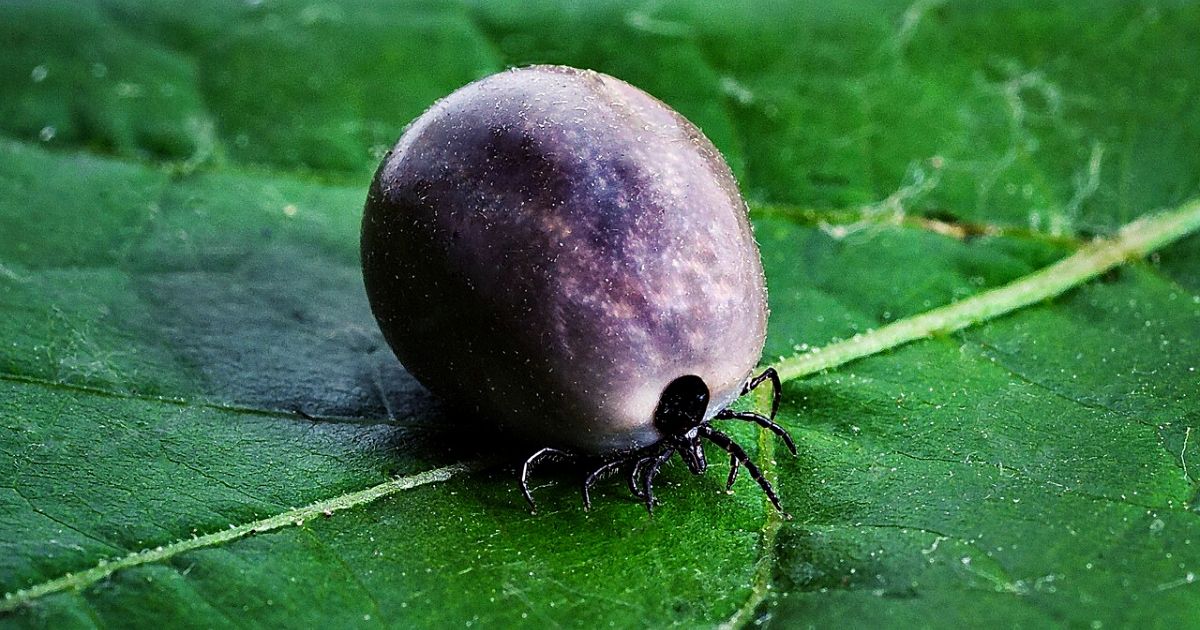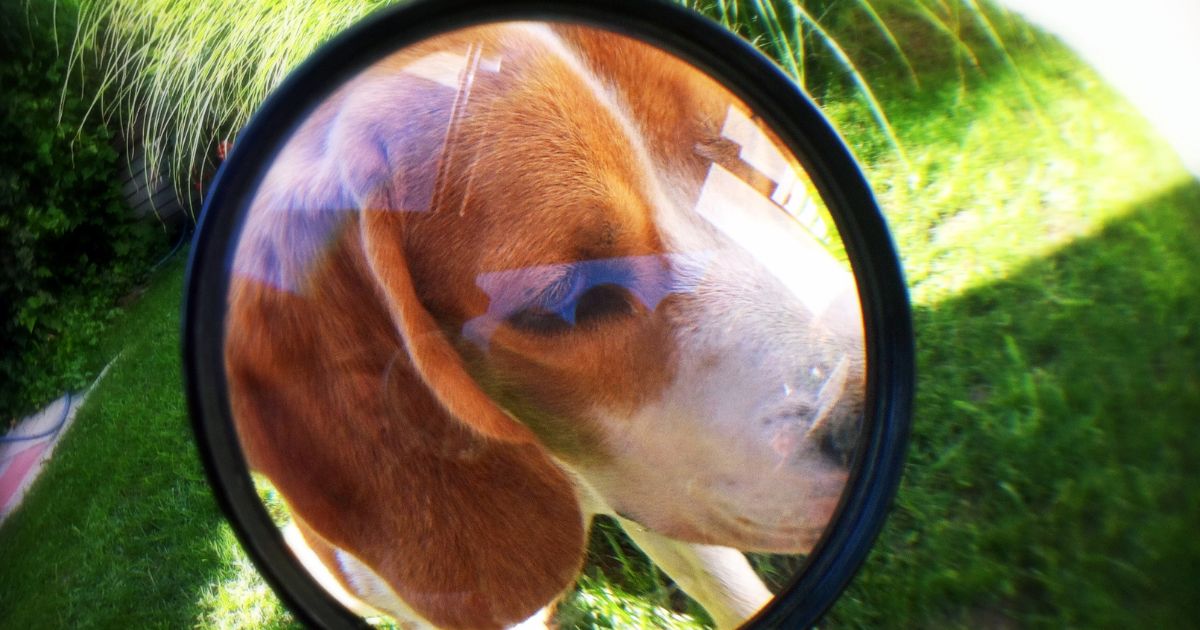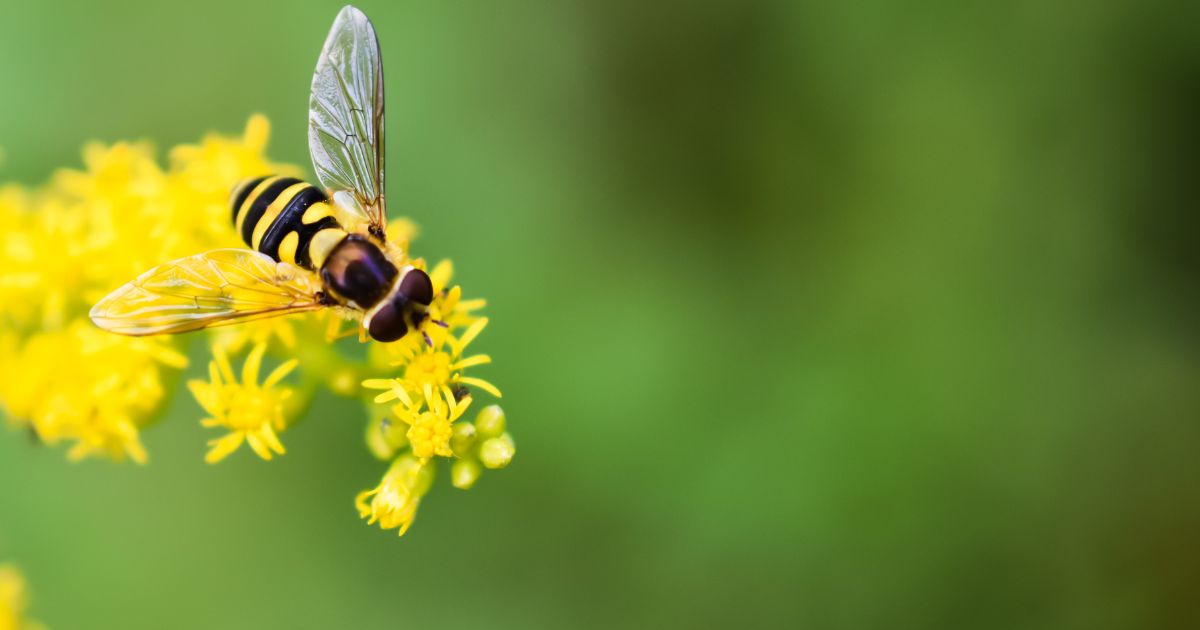The Complete Guide to Flying Ants Treatment and Prevention in Singapore
Pest Guides
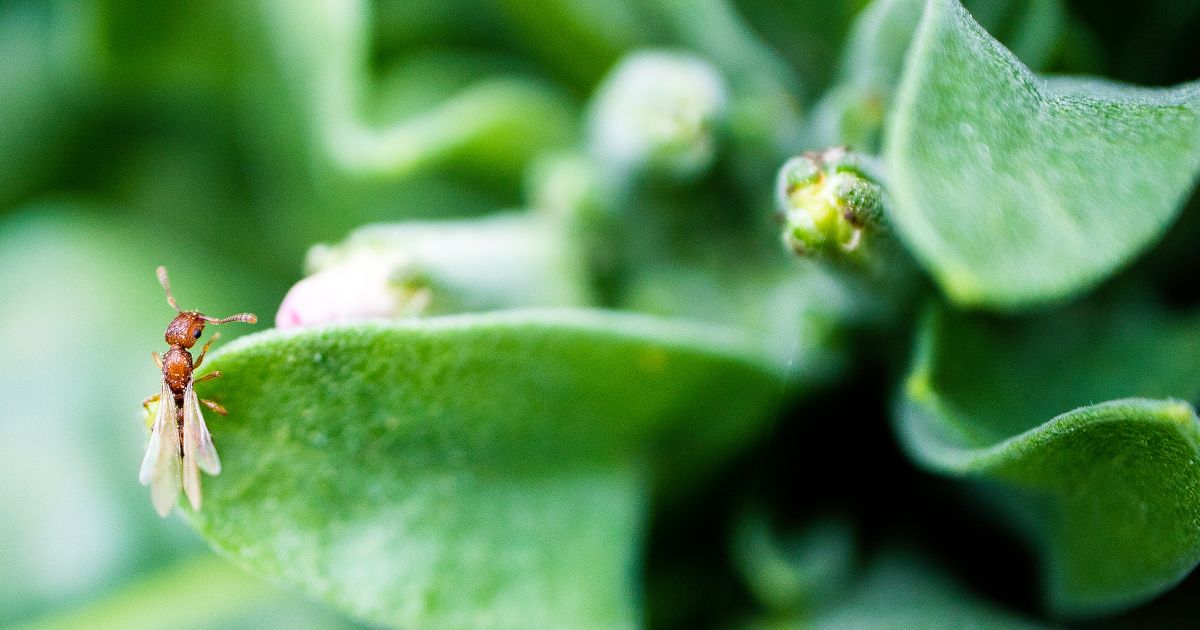
Flying ants can be occasionally seen in Singapore’s tropical climate, especially during the warm days of the rainy season. These ants are not dangerous for humans or pets, but their swarms can annoy homeowners. Understanding their behaviour and treatment methods can help you to effectively get rid of and prevent flying ants at your home.
Can Ants Fly?
Not all ants have wings and can fly, but all species of ants have flying “types” of ants within their colony. Flying ants, also called “alates”, are usually the reproductive members of the colony that develop wings during their mating period. When the colony is ready to expand, these flying ants emerge to mate and establish new colonies.
What Do Flying Ants Look Like?
Flying ants are typically black or brown with slender bodies. They look similar to winged termites, but some distinct features that can help you tell them apart. Unlike termites, ants have two pairs of wings that differ in size: large forewings and small back wings. Their bent antennae and narrow waist differentiate them from termites.
Want to find out more about ant control in Singapore?
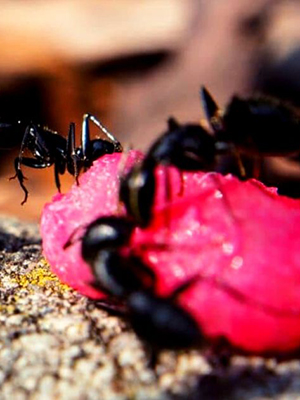
Why Do These Ants Fly?
Flying ants’ primary purpose is to reproduce and establish new colonies. It is an important part of the ants’ lifecycle. During warm and humid days, flying ants take flight in swarms to mate. Usually, the male flying ants die immediately after mating, and the fertilized females, known as queens, land to start new colonies.
Are Flying Ants Dangerous?
Generally, flying ants are not harmful to humans or pets. If a species of ants doesn’t bite or sting, their flying alates won’t bite or sting either. And if they do, it’s highly unlikely that alates will bite or sting you while flying.
However, when flying ants swarm in large numbers, they can still be intimidating or annoying to people and their presence may indicate an underlying ant infestation. Also, on rare occasions, people may experience allergic reactions to ant bites.
What Causes Flying Ants in Your House?
If you notice the sudden appearance of flying ants, it often indicates the presence of an established ant colony nearby. These colonies can exist in different locations, including the ground, structure of buildings or trees.
Usually, their emergence is triggered by favourable environmental conditions, such as temperature, humidity, and daylight hours. Several factors can attract flying ants to your house, including:
- Lights – you can notice flying ants swarming near windows, doors, or outdoor lights.
- Food sources – if you have any food or sugary drinks out, it will attract flying ants.
- Cracks in walls or foundations can also help flying ants find their way into homes.
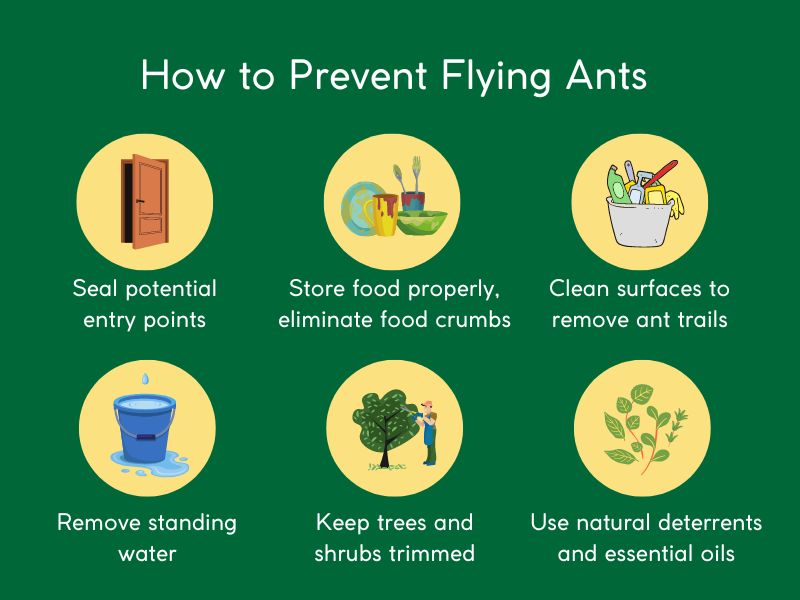
How to Prevent Flying Ants at Your Home
Depending on the species, flying ants can cause serious damage to your house and property. Here are some ways to prevent flying ants at your home:
Seal Entry Points: Make sure all cracks, gaps, and openings in walls, windows, and doors are sealed so that flying ants can’t get inside your home.
Store Food Properly: Ensure that all food is sealed and stored properly, and eliminate food crumbs or spills that can attract ants.
Maintain Cleanliness: Regularly clean surfaces to remove any ant trails.
Remove Standing Water: Address any moisture issues as flying ants are drawn to damp areas.
Trim Vegetation: Keep trees and shrubs trimmed away from your home to reduce entry points for ants.
Use Essential Oils. Some natural deterrents and essential oils with strong scents can draw the flying ants away from your house.
Ways to Get Rid of Flying Ants
If you are seeing flying ants in your house, there are a few things you can do to get rid of them.
- Vacuum up the flying ants and get the vacuum bag out of the house, so that they can’t find their way back.
- Try using fly traps to eradicate the flying ants inside your home.
- Use pesticides or natural ant control remedies, like mixing dish soap and peppermint oil. This will help you to get rid of flying and crawling ants.
- Find the ant colony by following the trail of ants to their origin place and try to get rid of it.
Pro Tip: Besides handling the flying ants themselves, it is also important to find and remove their source (colony).
By following these steps and knowing when to seek professional help, homeowners can reduce the presence of flying ants in their homes.
When to Call a Professional Pest Control Company
If you can’t get rid of flying ants, or if you have a severe infestation or persistent problems, consider contacting a professional pest control company. Trained experts can assess the situation, identify the source of the infestation, provide targeted treatments, and offer long-term solutions to prevent future infestations.

Pest Problem? Let Us Help.
We offer fast and effective precision treatments to eliminate pests while ensuring a safe environment for your home or business.
Author: Soleha Nisaa
Frequently Asked Questions
Some species of flying ants can bite, but it’s very rare for them to do so. They are usually a nuisance due to their presence rather than their biting behavior.
In most cases, the presence of flying ants isn’t a cause for serious concern. Their appearance is often a natural part of the ant life cycle. However, their sudden swarming can indicate the presence of an underlying ant infestation.
Flying ants in Singapore are often seen during specific periods, typically warm and humid days. However, their appearance can also depend on various environmental factors and the presence of established ant colonies nearby.
Flying ants themselves do not cause structural damage to buildings or property. However, if they establish new colonies inside structures, this can potentially lead to minor structural issues if left unaddressed.
Related Posts
The Complete Guide to Hornets Prevention, Treatment, and Control in Singapore
Pest Guides
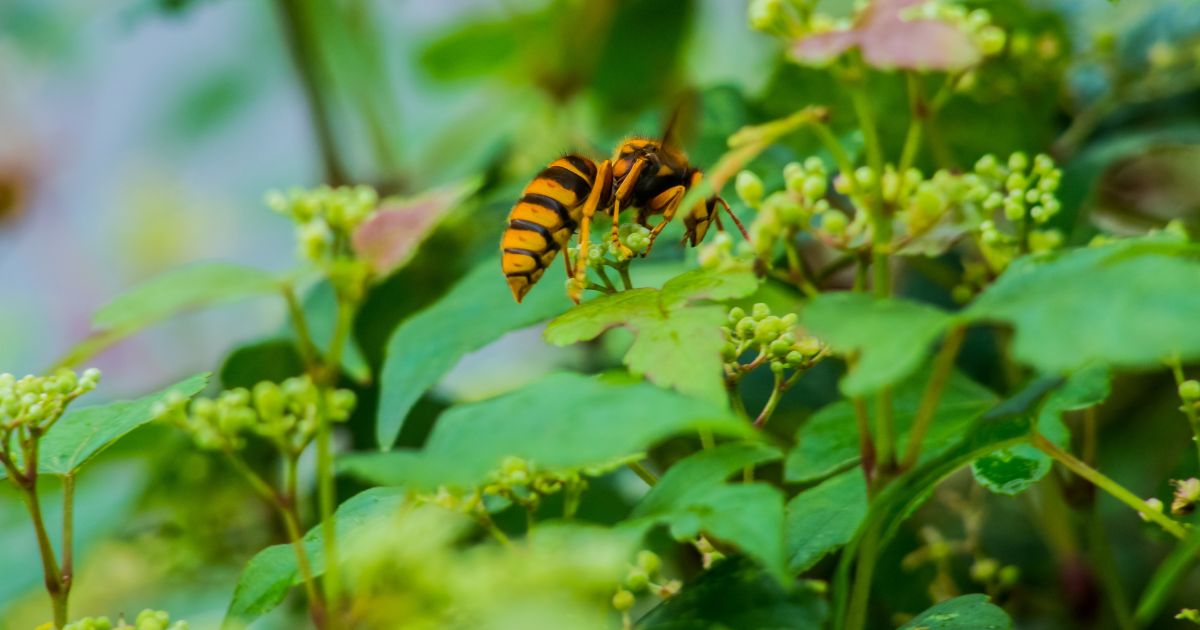
Hornets, a type of flying stinging insect, are found throughout the world, including Singapore. These insects are often confused with bees and wasps as they have a similar colour and shape. Similar to bees and wasps, hornets can build nests near your home and cause distress because of their painful stings. Explore everything you need to know about hornets in Singapore and how to get rid of them.
Table of Contents
- What’s the Difference Between Hornets vs Wasps
- Types of Hornets in Singapore
- Life Cycle and Biology
- Hazards of Hornets – Are They Dangerous?
- Signs of a Hornet Infestation
- How to Prevent and Get Rid of Hornets
- DIY Methods to Prevent Hornets
- When to Hire Professional Hornet Treatment in Singapore?
What’s the Difference Between Hornets vs Wasps?
In short, hornets are a type of wasp, being a specific subgroup within the wasp family. They are black and yellow in colour, but generally larger than other types of wasps. Like other wasps, they build nests and can have painful stings, but they also have some unique characteristics.
Types of Hornets in Singapore
There are several hornet species in Singapore with their unique characteristics. It is important to understand the difference between these species for effective pest control. Some of the hornets commonly found in Singapore include:
1. Lesser Banded Hornet
The Lesser Banded Hornet is small to medium in size (18-30mm) with a vibrant orange and black coloration. Usually, the Lesser Banded Hornet is non-aggressive and won’t attack unless provoked.
2. Greater Banded Hornet
Greater Banded Hornets are the larger cousins (24-30mm) of the Lesser Banded Hornets that also have striking orange and black coloration. They are more territorial and can attack when their nests are disturbed.
3. Yellow-Vented Hornet
Yellow-Vented Hornets are medium to large in size (20-34mm) and have a black coloration with yellow tip. They are less aggressive and will attack only if greatly provoked.
Life Cycle and Biology
Hornets are social insects that live in colonies. They usually have larger colonies and nests than other types of wasps. Hornet nests are common in Singapore and are found in homes and gardens, as well as parks and public areas.
Hornets typically build their nests in sheltered locations, such as tree branches, bushes, roof eaves, or even inside walls. They build their nests from a paper-like material they create by chewing wood and mixing it with their saliva. These nests can become quite extensive, housing thousands of hornets.
Want to find out more about wasp & hornet removal in Singapore?
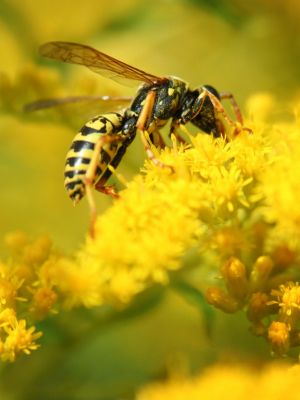
Hazards of Hornets – Are They Dangerous?
Hornets can pose hazards to humans because of their venomous sting. Hornet stings can be painful and, for some individuals, cause allergic reactions. Most people will only experience localized pain, swelling, or redness, but allergic people may suffer from severe reactions.
If you encounter hornets, it is important to stay calm and avoid disturbing them. Usually, they won’t sting unless they feel threatened or provoked.
Signs of a Hornet Infestation
Identifying a hornet infestation early is important for effective pest control. Common signs of a hornet infestation include:
- Hornets frequently flying around your property
- Visible huge nests, especially in sheltered areas
- Large number of dead hornets near your property
Common areas to look out for hornets include:
- Near doors and windows
- In the attic or roof space
- Under roof eaves and in wall gaps
- In trees and bushes in your garden
- Under playground equipment, garden benches or tables
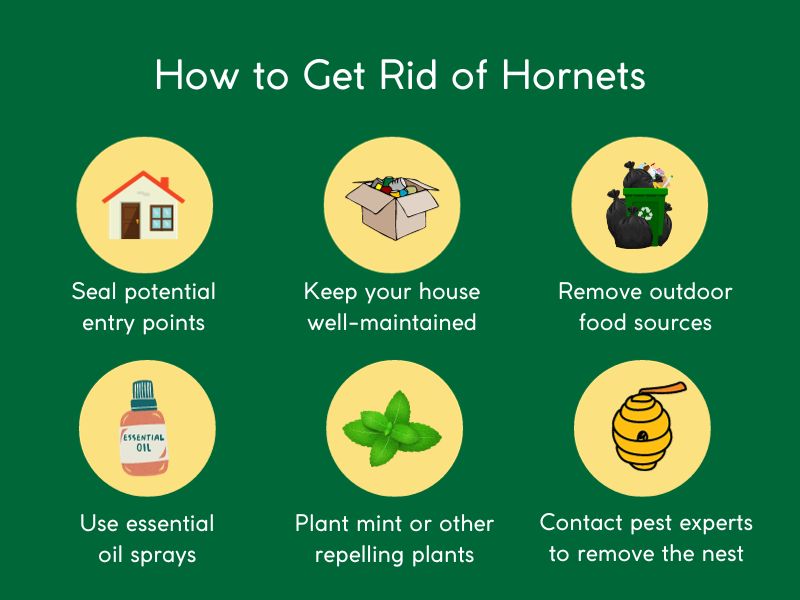
How to Prevent and Get Rid of Hornets
If you suspect a hornet infestation on your property, there are some steps you can take to address the issue.
Seal Entry Points: Prevent hornets from getting inside your home by inspecting it for potential entry points (and sealing them).
Regular Maintenance: Keep your property well-maintained, as hornets are attracted to decaying wood/paper and organic matter that they use for building nests.
Remove Food Sources: Hornets are attracted to food odors so it is important to keep outdoor food and trash bins tightly sealed.
Nest Removal: If you find a hornet nest near your home or in your garden, it’s best to contact a professional pest management company for hornet nest removal. It is not safe to remove hornet nests without proper skills and equipment.
Pro Tip: If you need help with a hornet infestation at your property, contact pest control professionals for safe and effective hornet removal.
DIY Methods to Prevent Hornets
While DIY methods don’t guarantee hornet prevention, they can be effective to some extent. Here are some common natural methods to prevent hornets from your property:
- Using Essential Oils: Some essential oils like peppermint or clove oil have a strong scent that can repel hornets and prevent them from building nests. To prevent hornets, mix a few drops with water and spray them in areas where hornets are active.
- Plant Mint or Other Hornet-Repelling Plants: Mint has a strong scent that can repel hornets and other insects. Planting them in your garden, on your balcony or near your home can also help keep hornets away from your property. Other hornet-repelling plants include wormwood and marigolds.

Pest Problem? Let Us Help.
We offer fast and effective precision treatments to eliminate pests while ensuring a safe environment for your home or business.
When to Hire Professional Hornet Treatment in Singapore?
If you have a hornet infestation, in most cases it is recommended to seek the assistance of a professional pest control service in Singapore. Killem Pest has the knowledge and equipment to handle hornet infestations effectively, safely and quickly.
Author: Soleha Nisaa
Frequently Asked Questions
It is recommended to hire licensed pest control professionals to handle hornet infestations and to follow their advice on preventive measures.
Yes, some birds and certain insects are natural predators and can help control hornet populations. Having a diverse ecosystem in your garden can lead to a balanced hornet population.
Yes, some eco-friendly approaches include using natural repellents and traps designed to catch hornets without harmful chemicals. These methods are less harmful to the environment.
Related Posts
How to Get Rid of Lizards In Your Home and Yard
Pest Guides
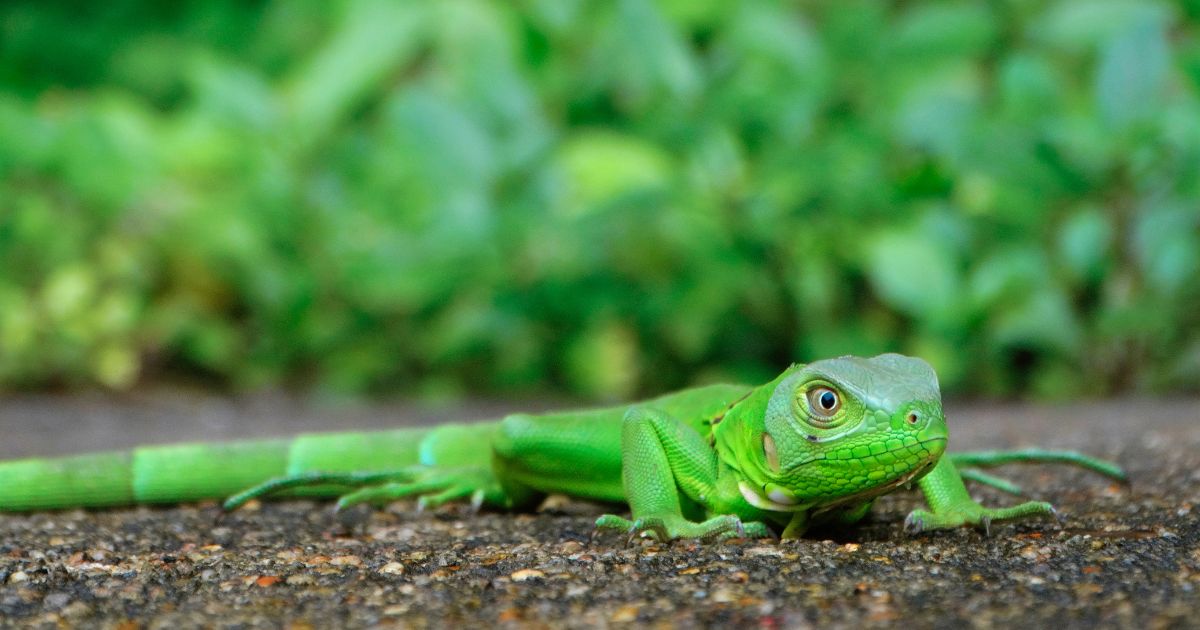
Lizards are generally harmless reptiles, but they can become a problem if they find their way into your home or yard. Luckily, there are some effective ways to get rid of them indoors and outdoors, and some eco-friendly home remedies to help you prevent lizards from your property.
What Draws Lizards to Your Home?
Before diving into solutions, it is critical to understand what attracts lizards to your property. The factors that attract lizards the most are food, water and shelter. Here are some key reasons why lizards can be drawn to your house:
- Lizards like to hide in warm spots or near electronic appliances.
- Lizards feed on insects, so if you have bugs or other small animals around your living space, lizards might be attracted to the food source.
- Lizards are attracted to moisture spots, including bathrooms and kitchens, leaky faucets or pet bowls

How to Get Rid of Lizards at Home
The best way to get rid of lizards in your home is to make it less attractive to them. This means that you need to remove any food or water sources, and seal any entry points like cracks and gaps. Here are some ways to get rid of lizards at home:
Seal Entry Points: Inspect your house and seal any holes, gaps and cracks that lizards can use to enter your home.
Reduce Room Temperature: Use fans or air conditioners to maintain a cooler environment and make your house less attractive for lizards.
Dispose Unused Food & Reduce Insect Populations: Keep your home clean and make sure it’s pest-free. Regularly clean up food crumbs and spills, dispose unused food, and seal food containers. Also don’t forget to repair leaky pipes, and use insect screens.
Vent Kitchen Cabinets: Properly ventilate dark warm places like cabinets to reduce humidity and prevent lizards.
Use Natural Lizard Repellents: Placing natural remedies like garlic, onion, and coffee grounds near entry points can keep lizards away from your house.
Limit Light at Night: Lizards are often attracted to light, so try to reduce outdoor lighting during the night.
How to Get Rid of Lizards Through Home Remedies
If you prefer natural methods to deal with lizards, there are a number of home remedies that you can use, including:
- Vinegar spray: mix vinegar and water in equal parts and spray it around your home. The vinegar smell will deter lizards from entering your home.
- Mothballs: place naphthalene balls in areas where you have seen lizards and their smell will also deter lizards.
- Eggshells: Crushed eggshells placed near lizard entry points can be effective in keeping them away.
- Pepper: Mix water and cayenne pepper or chili powder and spray this solution in areas where lizards frequent or near entry points.
- Onions and Garlic: Place slices of these aromatic vegetables in areas where you’ve seen lizards and their odour will repel lizards.
It’s important to note that while these natural methods can help repel lizards, they may not always be 100% effective. You may need to combine multiple methods and wait before you see the results. If you want a faster solution, you might want to consider consulting with a pest control professional for a safe and humane lizard removal.
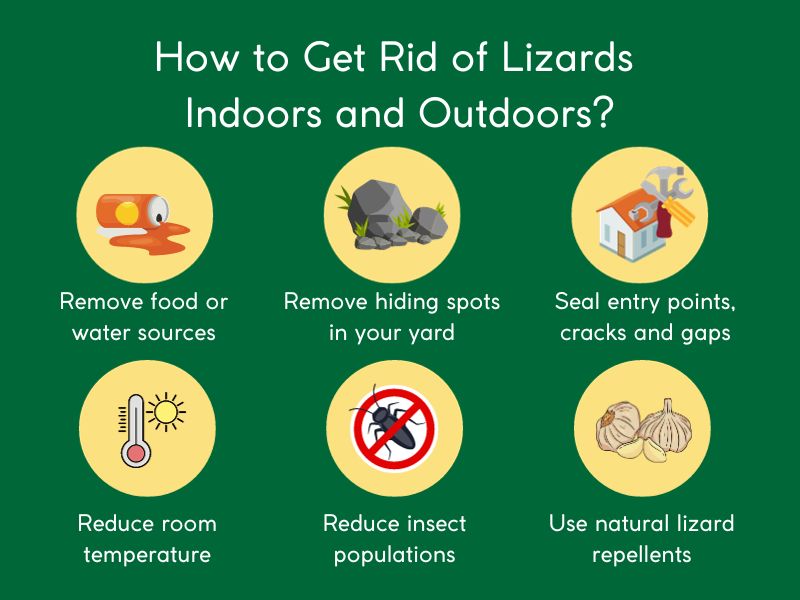
How to Get Rid of Lizards in Your Yard
Lizards in your yard can be just as annoying as those indoors. Here’s how you can get rid of lizards in your yard:
- Remove food or water sources that you have in your yard, like pet bowls or bird feeders.
- Remove any hiding spots – trim any overgrown vegetation, cover the compost pile, clear away piles of rocks, wood, or debris where lizards may hide.
Pro Tip: For fast, effective and safe removal of lizards, consider contacting a professional pest control company.
How to Get Rid of Lizards Without Killing Them
It might happen that DIY prevention methods won’t work for you. So how do you get rid of lizards without killing them? If you are having trouble getting rid of lizards on your own, you may want to contact a professional pest control company. They will use sustainable methods to safely trap the lizards and hand them over to NParks, who will then release the lizards in a safe location such as a park or forest.

Pest Problem? Let Us Help.
We offer fast and effective precision treatments to eliminate pests while ensuring a safe environment for your home or business.
Lizards are common in Singapore, but with the right approach, you can keep them from invading your home and yard. Remember to choose methods that are safe and harmless, and respect the lizards’ role in our ecosystem.
Author: Soleha Nisaa
Frequently Asked Questions
Lizards are generally harmless and can even help control insect populations. But if you’re uncomfortable with their presence in your living space, there are ways to manage them.
Lizards are not dangerous, but there can be risks involved in removing them, such as scaring them and causing them to hide in hard-to-reach areas. Always handle lizards gently to avoid stress or injury to the animals.
It may take from a few days to several weeks to see a significant reduction in lizard activity.
Yes, combining several methods is often the most effective approach to maximize your chances of keeping lizards away.
How to Get Rid of Fleas: Natural Ways to Kill Fleas
Pest Guides

Fleas are tiny pests that can be present in every household, but they are especially common in homes with pets. Their bites can cause itching and discomfort for both humans and animals, so it’s important to implement measures when you indicate the first signs of the infestation. While there are many chemical-based products available, opting for natural remedies is not only safer for your family and pets but is also better for the environment.
Are There Any Natural Ways to Kill Fleas?
There are several natural ways to kill fleas. Some effective methods include sprinkling herbal repellents or applying essential oils to the infested areas. You can also try using diatomaceous earth or salt to dehydrate fleas. Additionally, regular vacuuming and washing of bedding and fabrics can help eliminate fleas. Common products used to kill the fleas naturally include:
- Cedarwood
- Vinegar
- Baking soda
- Lemon spray
- Rosemary
Why Natural Remedies Are Beneficial for Fleas?
Opting for natural remedies to kill fleas offers numerous benefits when compared to chemical-based solutions, including:
- Safety for people and pets: Chemical solutions often contain toxins that can be harmful for people and pets if not used properly. Natural remedies, on the other hand, offer a safer way to deal with fleas’ infestation, minimizing the risk of adverse reactions or allergies.
- Eco-friendliness: Chemical solutions typically contain ingredients that can have negative impact on the environment and cause pollution. While natural remedies are a more environmentally-friendly and sustainable solution.
- Cost-effectiveness: Natural flea control methods are often more cost-effective than chemical treatments. Many natural remedies can be made using common household items (e.g. baking soda, vinegar, herbs) which are inexpensive.
- Long-lasting effects: Natural flea control methods may take longer to work than chemical treatments, but they often have long-lasting effects. By focusing on root causes of infestations and taking preventive measures, natural solutions can reduce the likelihood of future infestations.
However, despite all the listed benefits, it’s important to note that severe flea infestations may require the help of a professional pest control company.
Want to find out more about fleas removal in Singapore?

DIY Remedies to Get Rid of the Fleas in Your House
There are many DIY flea remedies that can help you prevent and get rid of the flea infestation in your house. Some options to consider include:
- Vacuum and steam clean regularly. Fleas are known to nest in carpets, rugs, and curtains, so it’s important to keep these areas as clean as possible. Thoroughly vacuum carpets, rugs, floors, furniture and other areas, paying special attention to corners and crevices where fleas can hide. After vacuuming, consider steam cleaning your carpets and washing bedding, curtains and other fabrics in hot water to kill fleas and their eggs.
- Maintain your house surroundings clean. Make sure that fleas don’t enter your home from the yard – trim your grass regularly and remove any debris or clutter that could attract fleas.
- Use diatomaceous earth on infested items to dehydrate the fleas and their eggs. Sprinkle diatomaceous earth on your carpets, furniture, and pet’s bed, and let it sit for a few hours before vacuuming it up.
- Use essential oils – these oils have a strong scent that can repel fleas. Just add a few drops of essential oil to a spray bottle filled with water and spray it around your home.
- Make natural flea sprays using ingredients like vinegar, lemon juice, and salt to repel the fleas.
- Using flea traps to attract and trap fleas.
Although DIY flea remedies can help you manage the infestation at some level, they may take longer to work and may not completely resolve the problem. In case of a severe flea infestation, it is better to consult with pest control professionals and take necessary measures before the infestation gets out of hand.

What Natural Oils Kill Fleas?
Essential oils are often used as a natural repellent to get rid of pest infestations. No wonder that they have also been known to have flea-repelling properties. Some of the essential oils that are known to be effective when dealing with a flea infestation include:
- Lavender
- Peppermint
- Lemongrass
- Eucalyptus
- Tea tree oil
When using essential oils, you can either add them in a diffuser or mix with water to create a spray and apply it to the infested areas. However, it’s important to note that essential oils alone may not completely eradicate a flea infestation. It is best to use essential oils in conjunction with other flea control methods.
Pro Tip: In case of a severe flea infestation, it is necessary to consult with pest control professionals along with using natural remedies for fleas.
Conclusion
Each infestation needs to be evaluated properly in order to determine the best course of action for your particular situation. While natural remedies for flea infestations work well in mild cases, if the situation seems out of control consulting with a professional might be the best solution.
Whatever method you choose it is essential to follow through and make sure that all potential hiding spots are treated with whatever approach you have selected. If getting rid of these pests has become an extra burden on top of your everyday activities don’t hesitate to contact Killem Pest as our experience and knowledge could make a world of difference when it comes to eliminating any flea infestation.

Pest Problem? Let Us Help.
We offer fast and effective precision treatments to eliminate pests while ensuring a safe environment for your home or business.
Author: Soleha Nisaa
Frequently Asked Questions
Yes, sunlight can aid in getting rid of fleas naturally. Fleas thrive in dark and humid environments, so exposing infested areas to direct sunlight can help kill them. However, it’s important to combine this method with other flea control measures for maximum effectiveness.
While professional treatments can provide immediate relief from a flea infestation, natural methods help in preventing future infestations and reducing reliance on chemical-based solutions.
If you have tried natural flea control methods for an extended period without success, or if you have a large infestation that poses a risk to the health and comfort of your family and pets, professional expertise is crucial for effective and efficient flea eradication.
Yes, pest management experts offer a comprehensive approach to flea control. They have access to a wide range of professional-grade products and treatments that can effectively eliminate fleas at all stages of their life cycle. In addition to treating infested areas, they can also provide advice on preventative measures to minimize the risk of future infestations.
How to Relocate Bees Without Killing Them
Pest Guides
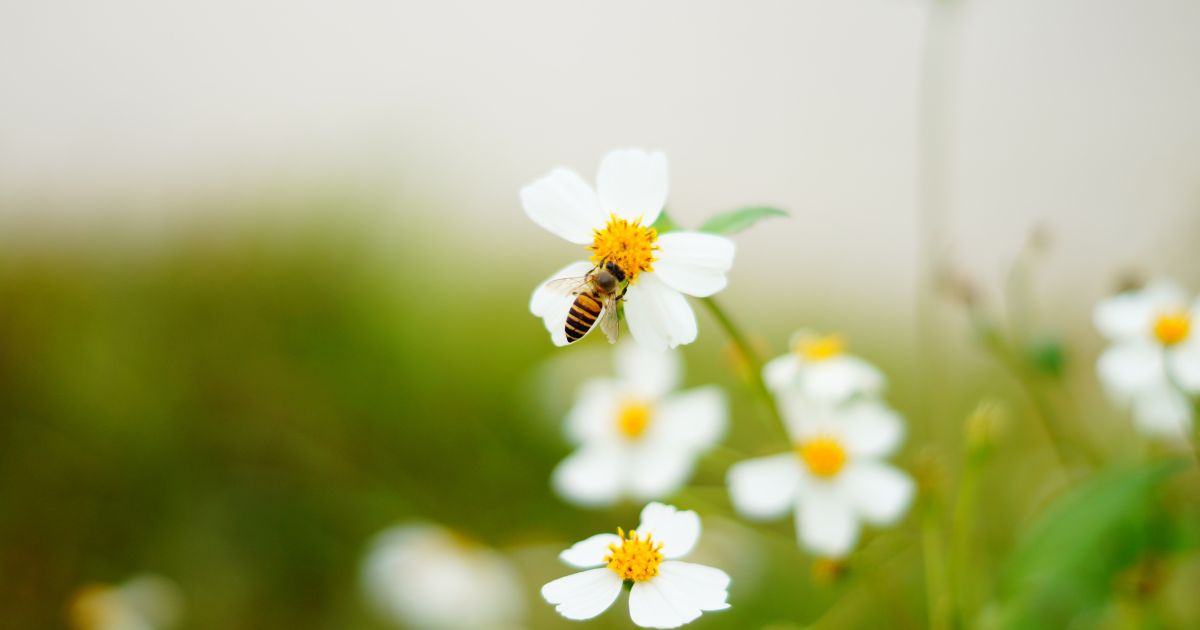
Bees play a vital role in the ecosystem of the planet. Besides offering honey, beeswax, pollen and other products, bees also help plants reproduce. They do this through pollination, a process whereby the bees take and spread the pollen from flowers. The bees thereby directly help plants, flowers, trees and other food crops to grow. Without bees, human beings would not have the same access to vegetables and fruits, and nature would be far less diverse. We need bees! In this article we will explore a unique approach to bee removal without killing them.
Why you should remove bees?
In many cases, there is no need to remove bees. They often locate themselves in trees away from urban areas. However, there are some cases where bees settle near a person’s home. If you leave them alone, they most likely won’t cause any issues. But sometimes the bees get too close for comfort and people prefer to call a pest control company to remove the bee hive.
These are some other common reasons why people prefer to remove bees:
- Allergic reactions: Some people are highly sensitive to bee stings, in rare instances even causing life-threatening reactions. It’s clear that a bee hive needs to be removed if the bees are located close to a person who has a bee allergy.
- Noise: Bees can be an annoyance due to their loud presence, especially when there is a large bee colony.
- Attract other pests: While bees are usually harmless by themselves, they can attract other pests like rodents.
- Structural damages: Bee hives occasionally cause structural damages to properties.
- Self-protection: Bees sometimes awkwardly and unknowingly position themselves close to areas where they themselves can get disturbed, such as near a highway or busy urban area.
If any of these situations applies to you, you may wonder what your options are. Many people think that killing the bee hive is the way forward, but here at Killem Pest we relocate the bees. The remainder of this article will focus on how to remove bees without killing them.
Pro Tip: Bee decline affects human lives, so it is important to control bees without killing them by hiring bee relocation professionals.
Can bees be removed without killing them?
The simple answer is yes: Bees can be removed without killing them. Killem Pest collaborates with The Sundowner Bee Rescue to not only safely remove bee hives, but to give the bees a new, safe home as well.
In this way, bees can continue their vital practice of pollination in a protected area.
Ways to remove bees without killing them
Removing bees by yourself may not be a smart idea. There are various safe ways to remove bees without killing them, and they all involve the help of a pest control professional and/or beekeeper. To handle a bee removal, you need to have the right protective equipment, knowledge as well as experience. So unless you have a background in beekeeping or pest control it is best not to attempt to remove the bees yourself.
A professional will start with identifying the type of bee and the size of the hive. They will sometimes apply smoke, not to harm the bees, but to calm them. This creates a safe foundation for removing the bees without killing them.
Then, when the bees are least aggressive, the removal job can take place. Depending on the type of bee, a beekeeper or pest control company will vacuum away the bees into a container or cut around where the bees are located, ie a piece of tree trunk. This can be a tough job, especially if the bees are located at higher levels. Once the hive is removed, it can then slowly be relocated to a new site where the bees can live a happy, carefree life.
Want to find out more about bee relocation in Singapore?
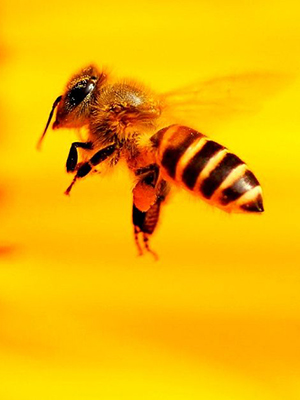
Early signs of a formation of bee hives
People often contact a professional when a bee hive is large. It is best to take note of the early signs of bee hive formations, as it will make a bee relocation job a little easier and safer. Also, by detecting bee hives in their early stages near properties, there is less risk of getting disturbed by the bees.
Scout bees, as their name implies, are bees who’s main role is to do field research. Their job is to find a suitable spot for a bee hive. If you suddenly notice lots of bees flying around, it may well be a bunch of scout bees.
Wax flakes are one of the first things bees make when they start building a bee hive. The flakes or small and have a white colour. They can be found on walls or in trees, basically near any potential settlement for bee hives. Spotting these wax flakes may be an early sign of the formation of a bee hive.
In general, the clearest sign of a potential bee presence is increased bee activities around your property. They may also be heard through their loud buzzing sounds.
So once you’ve spotted a bee hive, how to remove it?
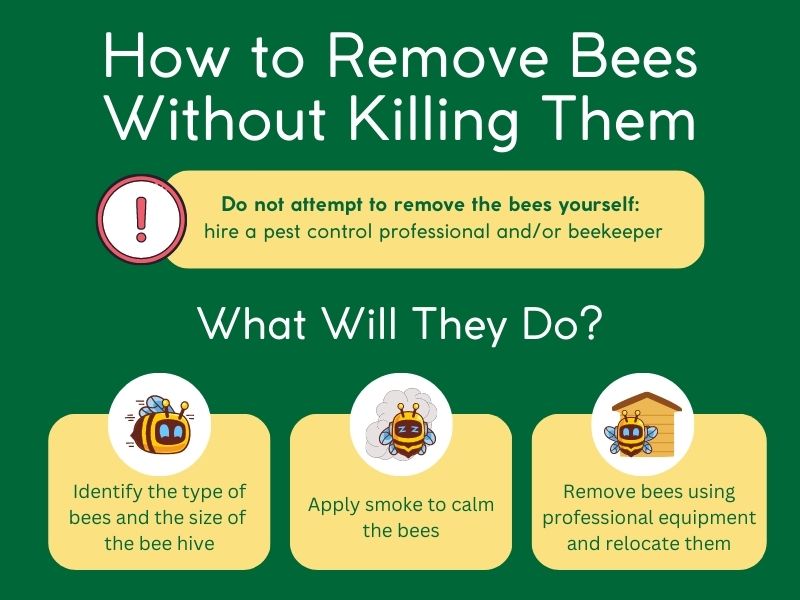
How to remove a bee hive
We’ve learned two main things so far when it comes to how to remove a bee hive safely:
- Don’t do it youself, leave it to a professional beekeeper or pest control technician
- There is no need to kill the bees, as they can be relocated
Killem Pest encourages the safe removal of bee hives without doing harm to the bees. We recognize that bees play an important role in the biodiversity of the planet, and that bees do far more good than harm.
Simultaneously, we know that bees can cause discomfort for people, especially when there are large swarms of bees.
Together with The Sundowner Bee Rescue, we offer a unique, sustainable approach to handling bee problems. While we provide help and expertise with safely removing the bees, The Sundowner gives the bees a safe home on their roof terrace, where they can live freely and enjoy the flowers that are abundant.
We believe this is the ultimate solution for bee issues in urban areas, and a solution that should be adopted by more pest control companies around the globe. Together we can save the bees!

Bee Problem? Let Us Help
We provide safe and efficient bee relocation services, ensuring the well-being of both your home or business and the bees themselves.
Author: Soleha Nisaa
Frequently Asked Questions
It is not recommended to relocate bees on your own, as it can be dangerous without the proper knowledge and equipment. It is best to contact a professional beekeeper or a pest control company that offers humane bee relocation services.
Most types of bees can be relocated, including honeybees, bumblebees, and carpenter bees. However, some species, such as Africanized bees, can be more aggressive and may require more specialized equipment and techniques for relocation.
Bees should be relocated to an area that is at least several miles away from their original location to prevent them from returning. It is also important to ensure that the new location has suitable resources and habitat for the bees to thrive.
If you have a bee infestation on your property, it is best to contact a professional pest control company that offers humane bee relocation services. Do not attempt to remove the hive or disturb the bees on your own, as this can be dangerous and can lead to further harm to the bees and yourself.
Bees can be naturally deterred by the smell of cucumber, peppermint, garlic, and citronella. Placing these near the hive or in the area where they are gathering can make the bees go away.
Ant Repellents: Natural Ways To Get Rid Of Ants
Pest Guides

We often get asked about simple DIY ant control methods. In some cases, natural ant repellents can be useful, but if you are looking to quickly and efficiently get rid of your ant problem, natural remedies are not recommended. Trained pest treatment professionals offer durable ant elimination treatments.
With that said, let’s take a look at some natural ant repellents.
Common home remedies for ants
Here is a list of 9 commonly mentioned natural ant repellents:
- Pepper
- Peppermint oil
- Lavender oil
- Neem oil
- Tea tree oil
- Lemon
- Coffee
- Cinnamon
- Vinegar
Does peppermint oil repel ants?
The scent of peppermint is not a pleasant one for many bugs including ants and mosquitoes. Peppermint oil extract offers a powerful, condensed form of the mint plant that acts as a natural ant repellent.
There are compounds available in peppermint that appear to repel ants, mainly menthol and thymol. The smell caused by the oil can also confuse ants, irritate them and they can even die because of exposure.
If you want to give peppermint oil a try, you can place about 15-20 drops of peppermint oil extract in a plastic bottle and mix it with water. All you need to do then is spray the mixture in the affected areas. Repeat the process every few days if needed.
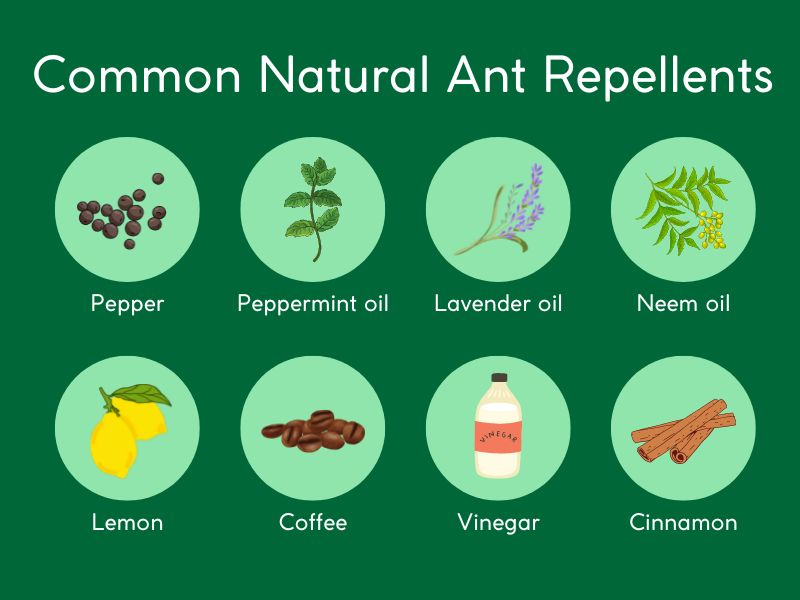
Does lavender oil repel ants?
Lavender oil is another powerful plant extract that is commonly referred to when discussing DIY ant repellents. Lavender flowers are known for their strong scent and are often used not just as pest repellents, but also in perfume. Generally speaking, human beings like the smell of lavender. To the contrary, pests like ants, flies and mosquitoes are not too keen on its smell. In fact, many store-bought natural pest repellents already contain lavender oil.
So how to apply lavender oil? Similar to peppermint, you can use a spray bottle and add a mixture of water and 15-20 drops of peppermint oil. Next, apply to the affected areas. You can also use a cotton balls for applying the mixture.
Want to find out more about ants removal in Singapore?
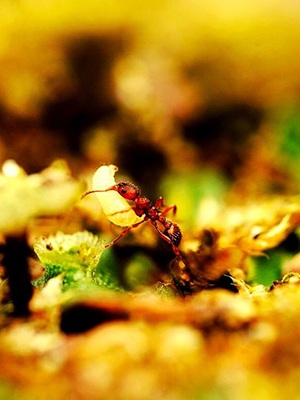
What's the best way to get rid of ants naturally?
There is no one right answer to this question. Each type of ant is different, each environment is different. And most importantly, the level of infestation plays a huge factor in whether or not natural ant repellents will work.
In Singapore alone, there are over 130 ant species. While many ants don’t like the natural pest repellents mentioned in this article, some will hardly be affected by it. Hence, you always need to keep a close eye on the presence of ants and consider contacting a pest control company in Singapore.
With that said, peppermint oil and lavender oil are two of the best known ant repellents that are worth trying out.
Pro Tip: Depending on the type of ants and the level of infestation, consider contacting pest management professionals to solve the problem before it gets even bigger.
How to prevent ants
While this article focuses on getting rid of an existing ant infestation, some of you may wonder how you can prevent ants in the first place.
As with most pest prevention tips, the first and foremost thing you need to is to keep food sealed. Ants are like hoovers and will come where there is food available. Cut off the supply of food and the likelihood of encountering ants drops significantly.
Other things you will want to do is avoid any standing water and keeping things clean, including emptying out the bins regularly.
Finally, denying access points as much as possible helps as well. That means making sure there are no cracks, holes or gaps where the ants can enter.
What if natural methods don’t work
Ants can be a real annoyance in your residence or at work. There are many treatment methods that include natural ant repellents. Some may work, some may not. The success depends on the size of the ant infestation and on the types of ants. In many cases you will need to contact a pest exterminator to get the job done once and for all.

Pest Problem? Let Us Help.
We offer fast and effective precision treatments to eliminate pests while ensuring a safe environment for your home or business.
Author: Soleha Nisaa
Frequently Asked Questions
Ant repellents are substances that are designed to repel or deter ants from entering an area. They work by emitting a scent that is unpleasant to ants or by creating a physical barrier that ants cannot cross.
Yes, natural remedies can be effective in getting rid of ants. These remedies work by disrupting the ants’ scent trail, making it difficult for them to navigate and find food.
Most ant repellents are safe to use around children and pets, but it’s important to read the label carefully and follow the instructions. Some ant repellents may contain chemicals that could be harmful if ingested, so it’s important to keep them out of reach of children and pets.
Yes, ants can develop resistance to ant repellents over time. This is why it’s important to rotate the use of different types of repellents to prevent ants from becoming immune to a particular substance, and contact pest control companies when natural repellents stop working.
The Ultimate Guide to Lizards in Singapore
The Ultimate Guide to Lizards in Singapore
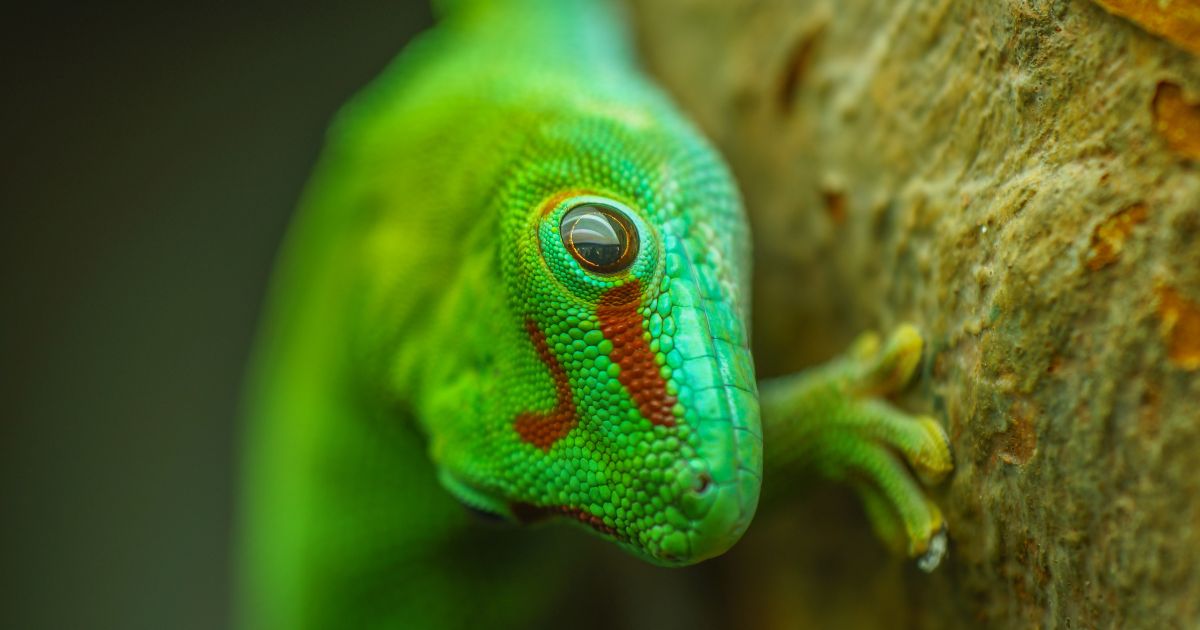
Planet earth is home to more than 6000 types of lizards. Many of these reptiles are known for their colourful appearance, especially the tiny geckos and iguanas. The large species known as monitor lizards is more common in Singapore. Lizards are generally harmless creatures, but there are some features that are worth noting.
Lizard biology
Lizards are closely related to snakes. Their build, copulatory organs and skull are identical. Most lizards have long tails and four legs.
Their colourful appearance is a special attribute of most types of lizards. The lizard family is so large that it is hard to describe their characteristics in too much detail. Geckos, for example, are tiny lizards (about 3cm long), while some species of monitor lizards can grow up to 3m long.
Most lizards eat insects, which actually makes them a genuine candidate to help with pest prevention. Iguanas are also part of the lizard family, though they eat plants instead of insects. The monitor lizard species are another exception. Besides insects, they also feed on snakes and fish.
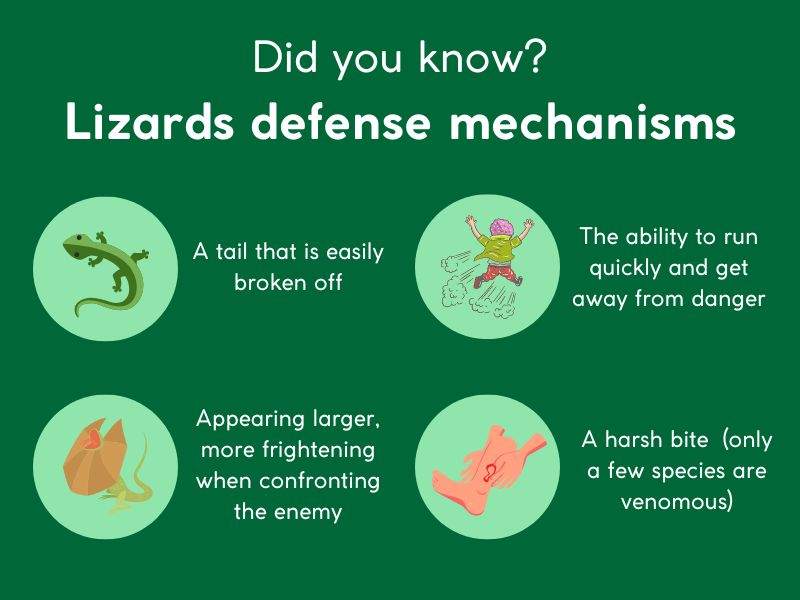
Types of Lizards in Singapore
There are many types of lizards in Singapore. We will focus on the species that are most common outdoors and indoors. The monitor lizards are active outdoors and fall under the Singaporean Wildlife Act, while geckos are known to be house lizards.
Types of lizards in Singapore:
- Malayan water monitor lizard
- Clouded monitor lizard
- Dumeril’s monitor lizard
- Four-Clawed Gecko
- Asian House Gecko
- Flat-Tailed Gecko
- Spotted House Gecko
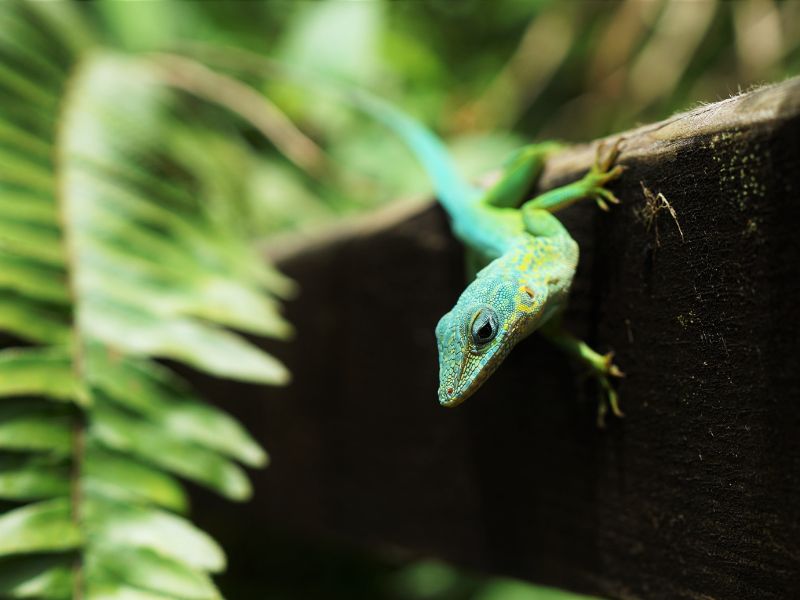
Monitor Lizards
The most noteworthy type of lizard in Singapore is the monitor lizard. Monitor lizards have various sub-types, including the Malayan water monitor lizard, clouded monitor lizard and Dumeril’s monitor lizard.
Monitor lizards are protected by Singapore law as they are considered to be wild animals. Under the Wildlife Act it is illegal to remove wild animals. In addition, monitor lizards fall under the Parks and Trees Act. As such, they are protected in nature reserves and other areas that are managed by the National Parks Board (NParks).
Killem Pest is accredited by NParks to trap and take certain wildlife in line with the Wildlife Act 1965.
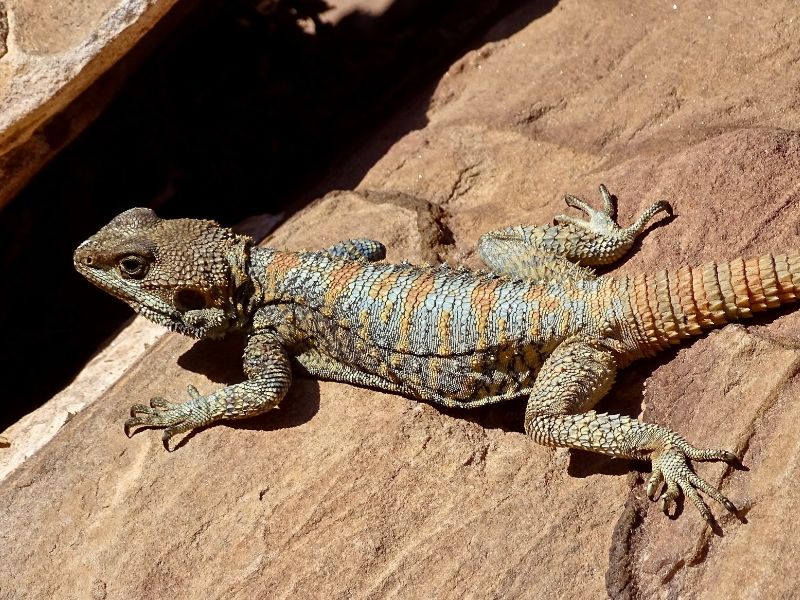
What to do if you see a monitor lizard?
Monitor lizards are shy and they generally stay away from humans. Only in rare cases will they attack you. Do not touch, chase or provoke monitor lizards as that can trigger an unlikely attack.
If you do receive a bite, you need to seek medical attention immediately. Monitor lizards are one of the few lizard species that are venomous, though the venom is not fatal to humans.
Unfortunately, poaching of monitor lizards in Singapore occurs. The National Parks Board advice is to take photo or video evidence if you encounter poaching, and to call the Animal Response Center: 1800-476-1600.
Pro Tip: If you notice a lizard at your home, do not try to catch and remove it on your own and contact pest management professionals.
Are house lizards dangerous?
House lizards (geckos) generally pose very little risk. In rare cases, lizards can carry salmonella. The droppings and urine can transmit salmonella. Keeping the house clean and food covered is a good practice to minimize the risk of salmonella.
As mentioned previously, some lizards are actually useful as they eat other insects. House lizards will do their best to eat flies and mosquitoes. If you have a lot of lizards at home, it is probably a sign of many insects in your house as well.
Want to find out more about wildlife management in Singapore?
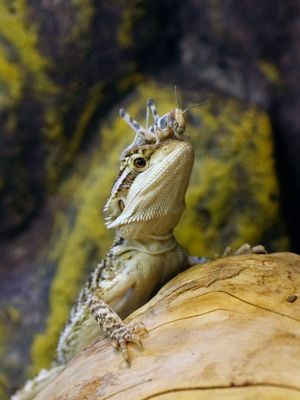
Are lizards pets or pests?
Whether you consider a lizard or any type of species to be a pet or a pest is totally up to you and your personal preferences. Mice are a good example. Some people keep mice as pets, but most people consider mice to be a pest.
In the case of lizards, the colourful iguanas are often seen as a pet. The small, tiny house lizards that come into your home uninvited and can cause health hazards, can be seen as a pest.
Where to find lizards around the home?
Lizards are attracted to dark and warm spaces. So, you’ll often find them behind doors, in cupboards and on the walls and ceilings. Standing water also attracts lizards.
How to get rid of lizards
There are several simple things you can do to get rid of lizards:
- Keep your home clean
- Cover food to prevent flies, which attract lizards
- Seal windows and doors

Wildlife Intrusion? Let Us Help.
We offer fast and effective solutions to ensure a secure environment for your home or business while prioritizing wildlife protection.
How to make a lizard trap at home
If you’re looking for a humane way to get rid of lizards at your home, an easy DIY lizard trap can be the answer. To create a lizard trap at home, you will need a clear plastic bottle, scissors, adhesive tape, and bait.
- Cut the bottle at about one-third from the top.
- Turn the top section you just cut upside down and insert it back into the bottle.
- Add your chosen bait, such as insects, water or small bits of fruit, to attract the lizard.
- Place the lizard trap in an area with lizard activity, and when you’ve caught one, release it safely outdoors.
Author: Soleha Nisaa
Frequently Asked Questions
Most lizards are harmless to people and will only attack you as a last resort trying to defend their life. However, you need to be aware of the bacteria that lizards carry, and a few venomous species.
Yes, lizards can be attracted to areas that are well lit and warm, so turning off lights can help prevent lizards from appearing in your home.
Lizard bites are very rare and happen when lizards feel threatened or get provoked. If you come into contact with a lizard, it’s important to remember to move slowly and avoid sudden movements, as this can startle the lizard and cause it to feel threatened.
Related Posts
How to Get Rid of Millipedes
How to Get Rid of Millipedes
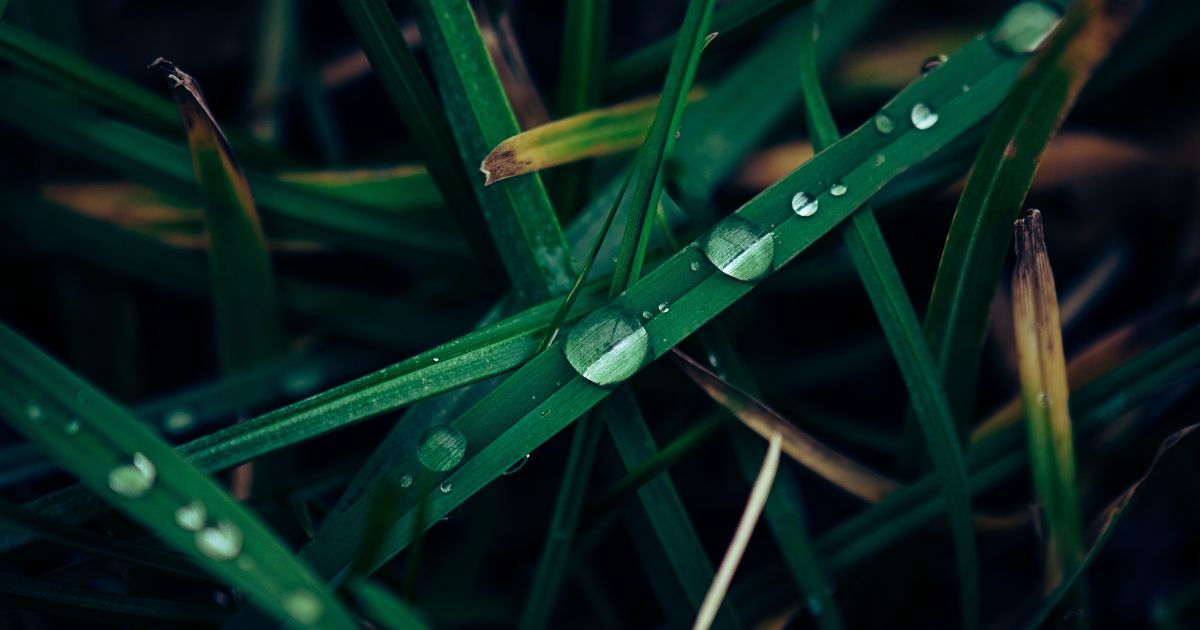
Millipedes are small, worm-like creatures. The name has a Latin origin:
- Mille (thousand)
- Pedis (foot)
The ‘thousand-feet’ creature is known to be active in Singapore, as they are attracted to moist and warm environments. Millipedes are close counterparts to centipedes. In this article, we will look at various ways to get rid of millipedes, both indoors and outdoors.
How to get rid of millipedes indoors
Generally, millipedes don’t come indoors, but in some case they do. There are several ways to get rid of millipedes indoors. The first thing to do is prevent entrance by sealing off any cracks or openings that may allow millipedes to enter your home.
You can also use a dehumidifier to keep the indoor area cool. Remember that millipedes are attracted to hot and humid areas. By controlling the indoor climate you can make it unappealing for millipedes. Also pay attention to any still-standing water and leaking pipes that will increase humidity levels.
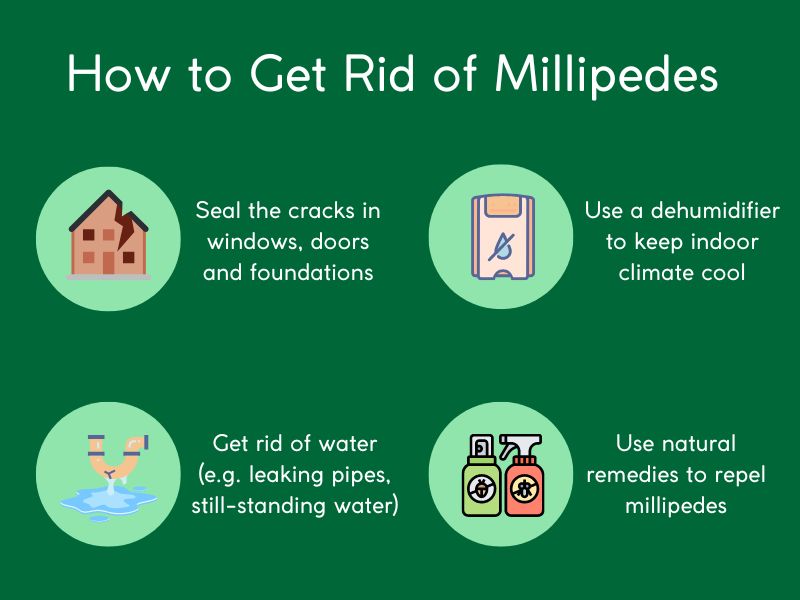
Will baking soda kill millipedes?
There are some natural ways to get rid or millipedes in indoor areas. Baking soda is a popular and widely-used method for various things, including as a millipede repellent. Sprinkle some baking soda in parts of your house where you think millipedes are active. Millipedes hate baking soda, so they will quickly move away.
Is neem oil suitable for getting rid of millipedes naturally?
Neem oil is another powerful natural treatment method for millipedes. The oil contains compounds that millipedes strongly repel against. All you need to do is spray some neem oil around your home. Pay special attention to the entry points to your home, in particular doors and windows.
How to get rid of millipedes outside
If you’re looking to get rid of millipedes outside, there are a few steps you can take. First and foremost, make sure to inspect your home or property regularly for any entry points that may allow millipedes into your home. If you find an opening, seal it immediately to prevent more millipedes from coming in. Additionally, get rid of any sources of standing water or debris around your home which can attract these bugs.
Want to find out more about pest maintenance programs in Singapore?
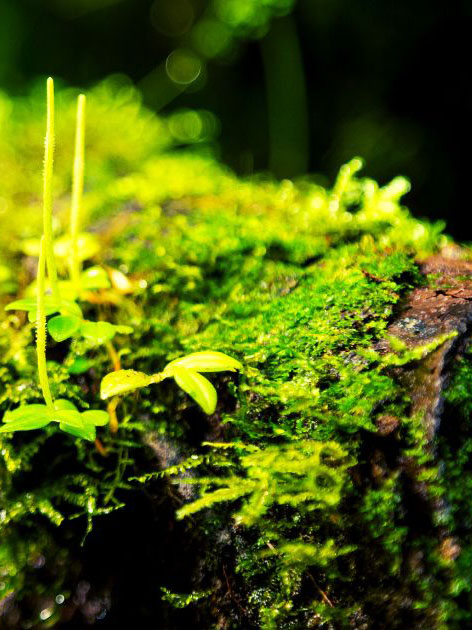
Will vinegar kill millipedes?
Vinegar is another powerful and natural method to get rid of millipedes. The contents of vinegar are so strong that it can kill millipedes upon contact. Make sure to apply it regularly to achieve optimal results. Note that if you there are many millipede larvae or eggs, vinegar will not be an effective treatment method.
Use a spray bottle and mix one part vinegar and four parts water to create an effective anti-millipede mixture. Apply it in the areas that are known to be popular for millipedes such as doors, windows and basements.
Does soapy water kill millipedes?
You may not think of it as a common pest treatment method, but soapy water does appear to be useful in some cases. Millipedes in particular are not too keen on soap. The soapy water suffocates and dehydrates millipedes, ultimately killing them. All you need to create the perfect mixture is to combine one part dish soap with four parts water in a spray bottle. Apply it in all areas of your home where you spot millipedes.
Pro Tip: Applying pesticides is the most effective and quick option to get rid of millipedes around your house.
Should I use pesticides for millipedes?
Pesticides are commonly used to treat pest infestations. The big downside of pesticides is that the chemicals can sometimes be toxic. However, when pest infestations are out of control, you may have no other option but to contact a pest control company to apply pesticides.
In the case of millipedes, we have already seen that natural treatments may not be very effective at getting rid of larvae and eggs. Pesticides offer a better solution. Contact your nearest pest control company to apply an effective pesticide treatment.
Conclusion
As we have seen, there are many things you can do to get rid of millipedes, both naturally and through a pest control company. There are some natural treatments that appear to be effective, but in many cases the millipede presence is so dense that it requires a proper pest-elimination plan to be executed.

Pest Problem? Let Us Help.
We offer fast and effective precision treatments to eliminate pests while ensuring a safe environment for your home or business.
Author: Soleha Nisaa
Frequently Asked Questions
Some common methods to repel millipedes include applying boric acid, cayenne pepper, or diatomaceous earth to the affected areas and across the home, and using yellow (sodium) lighting outdoors.
Millipedes hate tea tree oil and peppermint oil, so creating an essential oil spray and applying it around door frames, windows, and other entry points will help to keep millipedes away.
The most effective way to kill millipedes is spraying the perimeter and entry points of your house with insecticides and pesticides.
Related Posts
How to Get Rid of Booklice
Pest Guides

Booklice are tiny bugs that are relatively common in Singapore. Also known as psocids, booklice are especially attracted to warm and humid climates. Hence, Singapore is an ideal spot for booklice to thrive. The tiny bugs feed on mold and fungus, so you will often find them in kitchens and bathrooms. Books that are located in damp areas can sometimes be riddled with a booklice infestation. There are some things you can do to get rid of booklice. In this article, we will discuss 5 tips as well as some natural treatment methods.
Identifying Booklice
Before getting rid of booklice, it is important identify them accurately. They are tiny insects, approximately 1 to 2 mm in length. The colour of booklice varies depending on the species, but generally they are white or grayish-brown. Another specific way to identify booklice is by their six legs and antennae on their heads. Booklice also have wings but strangely enough they are not very good at flying. Do you recognize any of these characteristics when checking your surroundings for booklice? Then it is likely you have an infestation. Let’s look at ways to eliminate booklice.
5 tips on how to get rid of booklice in your home
Here are five tips to help you get rid of booklice in your home.
1. Reduce humidity
We know that booklice love the warm and humid environments such as the Singapore climate. Naturally, what you can do to reduce the presence of booklice is minimize moisture levels in your environment. You can use:
- Dehumidifiers
- Fans
These two tools help circulate the air and keeps the humidity levels low. In addition, check for any leaks as to avoid unnecessary added humidity indoors.
Pro Tip: If you have a large booklice infestation, using strong dehumidifiers will help reduce the excessive amount of moisture and eliminate the booklice.
2. Clean up debris
We often talk about keeping your home and offices clean at all times. This helps prevent and get rid of not just booklice, but all types of pests. So regularly clean the counters, hoover the floors, get rid of thrash and keep all food items sealed airtight. Basically, your job is to remove all items that attract pests such as booklice.
3. Use insecticides
Cleaning your home and reducing the humidity levels may not be enough, depending on the stage of the booklice infestation. You may need to use insecticide sprays targeting booklice. While we generally advice to go for tip 5, if you do decide to take action yourself, make sure to reach the instructions of the insecticide carefully when applying chemicals indoors.
4. Seal cracks and crevices
Cracks and crevices are on the main reasons pests get access to your home or office. So make sure to check all rooms, corners, windows and doors for any cracks and crevices. Apply the correct sealing materials to help keep booklice away.
5. Contact an exterminator
If all else fails, Killem prevails. We are a professional pest control company in Singapore with experience treating booklice for more than 30 years. We can offer specific and effective pest treatments to get rid of your booklice problem in no time.
Want to find out more about pest maintenance programs in Singapore?

Natural solutions to get rid of booklice
So far we’ve talked about the main tips to get rid of booklice. Now let’s look at some natural solutions, as this is something people frequently ask about. A side note here is that natural solutions may sometimes not be effective depending on the size of the booklice infestation.
If you do want to try out natural solutions, one of the more effective ways to eliminate booklice is to use essential oils. Peppermint oil and tea tree oil may be good starting points. They can be used as a spray by diluting it with water and then spraying onto the infested areas.
Vinegar solutions may also provide a good natural treatment option. Mix one part with vinegar with one part water in a spray bottle. Then apply the mix to the infested areas. Be careful, this is a strong mix that could discolour items in your home or office.

How to prevent future booklice infestations
If you’ve applied any of the tips from above, you will have hopefully found a solution for your booklice infestation. You may now be wondering how you can prevent future booklice infestations.
Let’s start with the bookshelves. Make sure to position bookshelves away from walls where moisture tends to be most present. We also recommend continuing to use dehumidifiers frequently as this helps keep the environment unappealing for booklice.
Regular cleaning will help keep booklice away. This includes vacuuming, sealing food and especially keeping the kitchen clean.

Pest Problem? Let Us Help.
We offer fast and effective precision treatments to eliminate pests while ensuring a safe environment for your home or business.
Conclusion
We know that booklice can cause real problems if their presence goes by undetected. By applying the right measure to get rid and prevent booklice, you can make sure to be free from booklice infestations. Focus your attention on all the items that make the environment unappealing for booklice, such as lowering the humidity levels. Finally, if you are unsure of what to do or all your efforts appear to have no impact, contact your nearest pest control exterminator.
Author: Soleha Nisaa
Frequently Asked Questions
Getting rid of the infested items, reducing the humidity and increasing ventilation will typically kill booklice in your home.
Check the common spaces that get infested with booklice, such as kitchen cupboards and appliances, books and magazines, storage rooms, and other humid dark places in your home.
Freezing containers, products, and books for 24 hours can kill booklice at any stage of their life span, including when they are still just eggs.
Related Posts
The Ultimate Guide to Scorpions
Scorpions are arthropods that are related to spiders. Some features of scorpions are that they have a long tail with a stinger on the end and a set of pincers on the front of the body. In this article, we discuss some interesting and useful facts about scorpions. There are scorpions in Singapore along with other stinging pests such as bees, wasps, and hornets. Scorpions occur in many different types of habitats including deserts, but in Singapore, they are most often found inhabiting forested areas.
Scorpion biology
Scorpions are predators that feed on other small creatures that they come across in the environment. Mostly they prey on insects and tiny arthropods, but larger-sized scorpions may even take small vertebrates such as lizards.
They have a flattened segmented body and jointed limbs. A scorpion also has four legs, a pair of pincers near the head area, and a tail with a stinger. The average size of a scorpion is about 6 cm.
They breed during the warm season or year-round in the tropics. The mating process involves a complex courtship ritual. Scorpions can mate many times and the females have live births. The average number of offspring is 25.
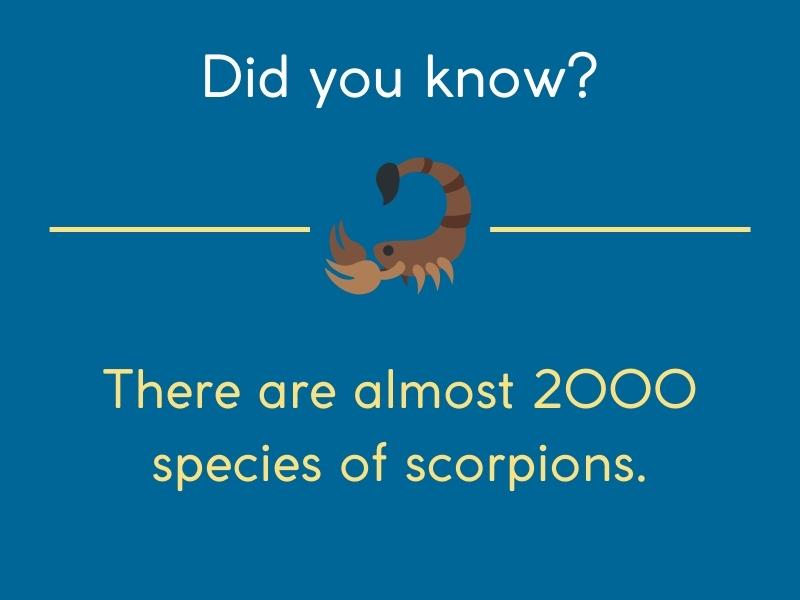
Types of scorpions
There are many different types of scorpions (almost 2000 species of scorpions) found in many habitats around the world. In Singapore, the most important species of scorpions are listed below next to the family name:
Family Buthidae
- Lesser brown scorpion – Isometrus maculatus
- Long-tailed scorpion – Lychas scutilus
Family Chaerilidae
Family Hemiscorpiidae
- Dwarf wood scorpion – Liocheles australasiae
Want to find out more about wildlife management in Singapore?

Do scorpions bite?
Scorpions do not bite normally, instead their defense mechanism is to sting. You should avoid touching and picking up a scorpion because you risk receiving a painful sting that may be harmful to you.
Are scorpions poisonous?
Scorpions are not considered poisonous; however, all species are venomous to some extent. This means that they contain venom in their tail which they inject when they sting someone. The venom of a scorpion is a toxic substance that directly affects the nerves or blood cells. The exact type and potency of the venom vary depending on the specific species of scorpion.
Did you know: Scorpions cause over 3000 human fatalities a year world-wide.
Are scorpions dangerous?
Scorpions can be deadly; they do cause over 3000 human fatalities a year world-wide. However, not all species are dangerous to humans. In many cases, the venom may not be dangerous for people.
There are a few that are more harmful to people. The most dangerous scorpions are in the two scorpion families: Scorpionidae and Buthidae. They are responsible for almost all cases of human injury.
Which are the most dangerous scorpions?
Although Scorpionidae looks more intimidating since they have larger pincers, it is actually the Buthidae that are more venomous, even deadly at times. The Buthidae have smaller pincers and a thicker tail than the Scorpionidae but the venom they produce is much stronger.
Many scorpions do not kill humans when they sting them but the sting can cause pain and swelling. Another concern is the possibility of an allergic reaction that can even lead to anaphylaxis.
The sting of any scorpion could cause anaphylaxis in vulnerable individuals. Anaphylaxis can quickly cause death, so it is best to rather avoid direct contact with scorpions. Even if you have never before had a dangerous allergic reaction it can still happen with any type of sting.
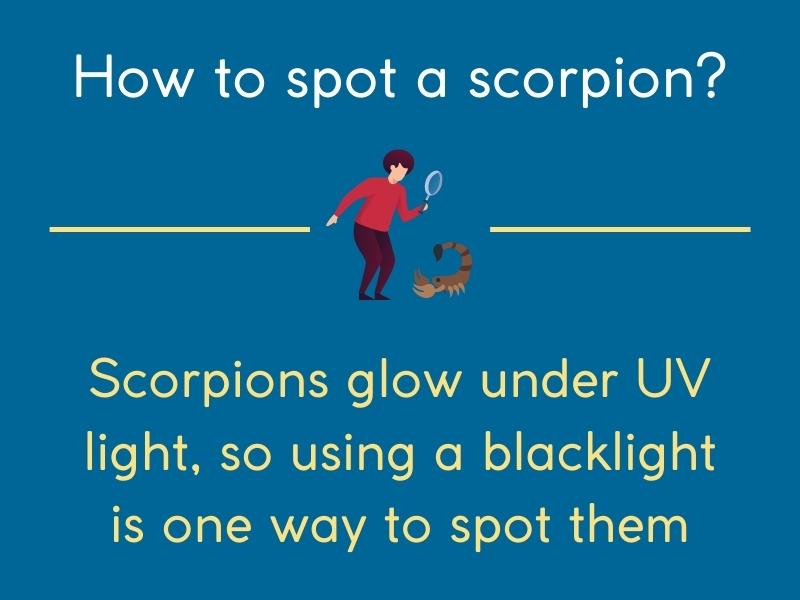
How to spot a scorpion
Scorpions are active at night and many show up under ultraviolet light, so using a blacklight is one way to spot them. They often hide under logs or fallen debris. In houses, you could potentially find them in crawl spaces and attics. Scorpions prefer darkened spaces in dwellings, such as cracks and joints where they can hide out during the day.
How scorpions can enter your home
Scorpions can enter a dwelling through small cracks and holes. These insects are flat-bodied and can even crawl under doors, so having weather-stripping in place is a good idea.
These arthropods are predators that feed on other arthropods including insects like crickets. An infestation of crickets or other insects in your home may attract scorpions looking for food. You may not even know you have a scorpion in the home until you happen to spot one.
It is not common to have many scorpions infesting a home. However, they can be dangerous to people and pets depending on what type they are.
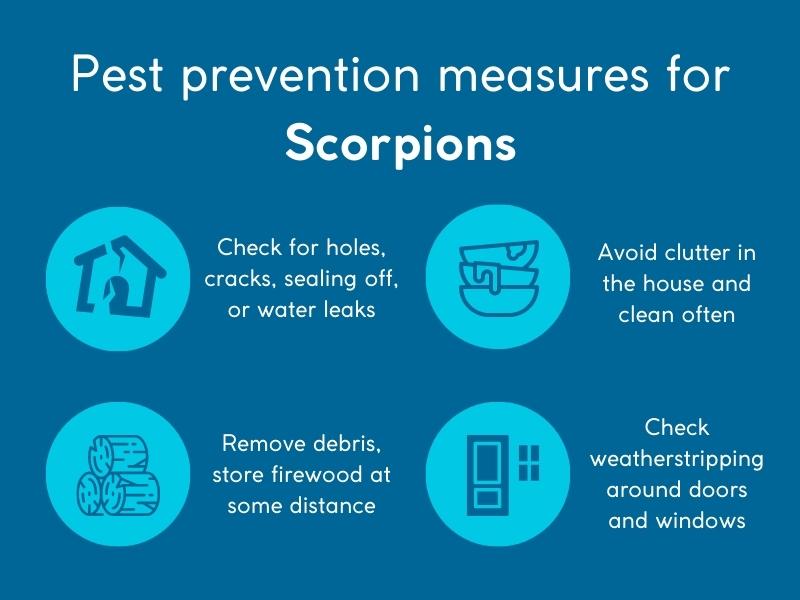
Pest prevention measures for scorpions
- It is better to prevent the entry of scorpions and other small pest insects into the house, to begin with. This can be accomplished by checking for holes and cracks and sealing off and repairing where needed.
- Make sure weatherstripping around doors and windows is in good shape.
- Check for water leaks since this attracts scorpions and other noxious insects like cockroaches.
- Avoid clutter in the house since this provides hiding places for scorpions.
- Clean the house often; this is a good way to notice if there are pests present.
- Remove debris close to the house since this can attract scorpions.
- Make sure firewood is being stored some distance from the house since this also will be attractive to scorpions and other pest insects.
- If you suspect a scorpion may be present, invest in a blacklight and search at night for any signs of the animal. They will glow under UV light and be easy to see.
Pest control measures for scorpions
Scorpions are usually simply directly killed by spraying them with insecticide. Fogging is not required unless you have a big infestation of some other type of pest like cockroaches.
Always be careful using insecticides in the home, especially if you have pets and small children.

Wildlife Intrusion? Let Us Help.
We offer fast and effective solutions to ensure a secure environment for your home or business while prioritizing wildlife protection.
Conclusion
Scorpions are arthropods that sting with their tail. The venom of many species is not a big concern to humans but pets and small children are at higher risk. Even though most species will not kill you it is wise to prevent scorpions from entering your home.
Frequently Asked Questions
Although scorpions and insects have some similarities, scorpions belong to the class of animals known as the Arachnids. This makes scorpions a distant relative of spiders.
First, scorpions use their claws to grab the prey; smaller victims get crushed and killed with the scorpion’s grip. Then, scorpions sting the prey with its tail to inject the venom.
Usually scorpions won’t attack people, unless they feel threatened. Their stinging is the defence mechanism against being attacked or getting crushed.
Scorpions are not considered poisonous; however, all species are venomous to some extent. Only some of the species produce the venom that is deadly.
The most dangerous scorpions are in the two scorpion families: Scorpionidae and Buthidae. They are responsible for almost all cases of human injury.
All scorpions will glow in the dark under a ultraviolet (UV) light, also known as a “blacklight”. This is caused by an unidentified substance in their skin.
In addition to deserts, scorpions can also be found in tropical and subtropical environments, such as grasslands, savannas, and forests.
Most scorpions hide under rocks, logs, clutter or boards. This is why you should avoid clutter and debris around and in your house, and make sure there are no holes or cracks for scorpions to hide.
Related Posts
The Ultimate Guide to Monkeypox
Monkeypox is one of the orthopoxviruses that can infect people and cause illness. Prior to 2022, monkeypox was rather limited in distribution, occurring in countries in Central Africa and West Africa. The most recent outbreak started in May 2019 with a single monkeypox case detected in Singapore.
The patient had traveled from Nigeria, where monkeypox is actually endemic. Monkeypox in Singapore has since been confirmed in more patients. A total of 15 men in Singapore have been confirmed as monkeypox cases. Read on to learn more about monkeypox.
Where Did Monkeypox Come From?
Monkeypox was first identified in the 1970s in the Democratic Republic of Congo in Africa. The belief is that the virus spread from a mammal to a human at some stage. Monkeypox is, therefore, called a sylvatic zoonosis since the virus has spread from a natural animal host to humans.
Monkeypox can occur in a variety of mammals including rats, shrews, squirrels, hedgehogs, and anteaters. Scientists suspect that the virus was at some stage transmitted from a rodent to a human.

Monkeypox Symptoms
The signs of monkeypox appear anywhere from 7 days up to 21 days after exposure to the virus. Not all the symptoms are present in every infected person. The person stays contagious for up to a month when all the pustules should have scabbed over and fallen off.
The symptoms of monkeypox include the following:
- A rash that occurs on the face, chest, hands, and genitals. The rash consists of vesicles that form blisters. The vesicles can be itchy and also very painful.
- Fever of more than 38°C
- Chills
- Headache
- Swollen lymph nodes
- Muscle pain
- Respiratory signs such as a cough, a sore throat, and a stuffy nose
Complications of Monkeypox
There are some dangerous complications that can occur in people who have monkeypox. These complications are listed below.
- Encephalitis
- Bronchopneumonia
- Corneal infection that can lead to blindness
- Death
Monkeypox can lead to death in anywhere from 1% to 10% of cases depending on the country where the outbreak occurs. The average worldwide death rate for monkeypox is about 3% to 6%. Individuals who have a compromised immune system, infants, and children are especially susceptible to severe illness and complications.
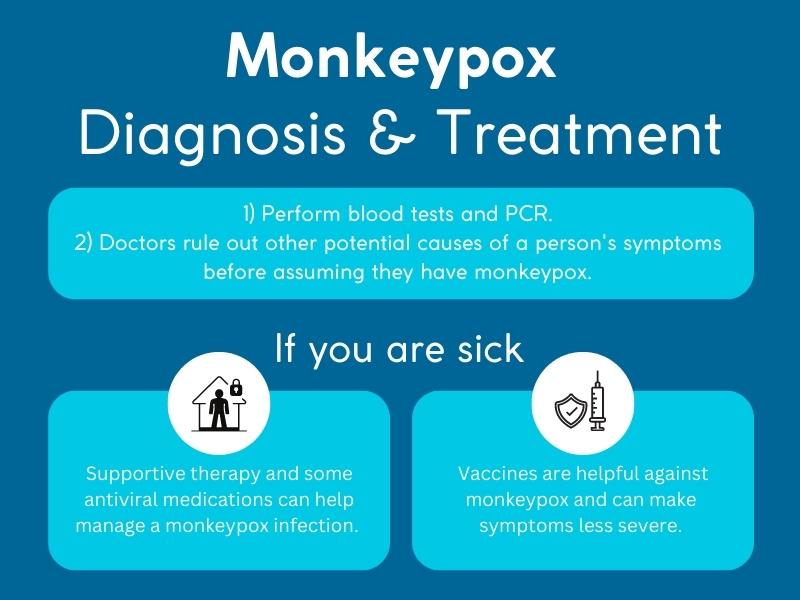
Monkeypox Diagnosis
Diagnosis of monkeypox is usually by blood tests and PCR. PCR is the best way to detect the virus and is better than immunology tests looking for antibodies. The infection is still less common than other rash-producing illnesses so doctors need to eliminate other potential causes of a person’s symptoms before assuming they have monkeypox. Travel history of the person and contact with individuals already diagnosed with monkeypox raises the level of suspicion that the person has the monkeypox infection. Molecular tests such as PCR can confirm the diagnosis, as previously mentioned.
Want to find out how to protect space from Monkeypox in Singapore?

Monkeypox Treatment
Treatment is difficult since monkeypox is caused by a virus, which means antibiotics will not work. Supportive therapy and some antiviral medications can help manage a monkeypox infection. The antiviral tecovirimat has been used to treat some cases of monkeypox.
Supportive therapy includes giving patients fluid and helping them keep their nutrition up. Many people do recover after a few weeks.
There are at least two vaccines that are somewhat helpful against monkeypox and can make symptoms less severe. The Ankara vaccine was developed for monkeypox in 2019 but it is not always easily available.
Pro Tip: The best way to prevent monkeypox is by avoiding close contact with infected areas, people or animals.
How Monkeypox is Transmitted
People can catch monkeypox from eating uncooked bushmeat. A person can also become infected if bitten or scratched by an animal that is infected with monkeypox.
Transmission among people is by close physical contact. The virus spreads by contact with:
- body fluids such as saliva, semen, blood, fluid from blisters, and urine
- the monkeypox skin lesions
- articles of clothing and linen used by the infected person
- respiratory droplets
The virus can also spread from a mother to her fetus. This has resulted in fetal deaths.
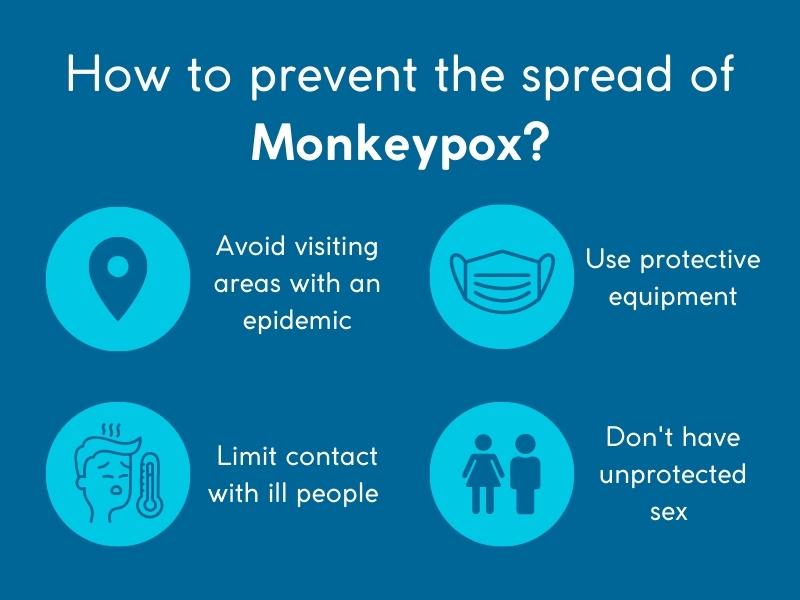
Monkeypox Prevention
You can prevent catching monkeypox by following some simple rules outlined below.
- Avoid visiting areas where monkeypox is endemic, or if unavoidable, take extra precautions in those countries.
- Avoid close contact with people currently ill with monkeypox.
- Do not have unprotected sex because this is one way the disease is spread among people.
- Health workers need to use protective equipment and take care to avoid infection when treating people who are sick with monkeypox.

Concerned About Monkeypox? Let Us Help.
We provide fast and effective disinfection solutions to eliminate harmful germs and viruses, ensuring a safe and hygienic environment for your home or business.
Conclusion
Monkeypox is a serious illness that can result in death. The symptoms are similar to many other illnesses meaning that diagnosis may be difficult initially. There are also limited treatment options for monkeypox, which is why your best strategy is to try to prevent becoming infected in the first place.
Frequently Asked Questions
Rodents are thought to be a likely natural reservoir of the monkeypox virus. This means that the virus is quite commonly found infecting rodents.
Rodents can and do transmit monkeypox. In fact, the presence of monkeypox in the western hemisphere has been linked to infected rats that came from Africa. In the United States, a past outbreak occurred when rats imported from Africa infected prairie dogs. People then became infected when coming into contact with the infected prairie dogs.
Since rodents do carry monkeypox, pest control methods can potentially help decrease the chance of getting infected by eliminating rodent pests in the home.
There is not currently a vaccine that is only for monkeypox, however, people who have had the smallpox vaccine may have some protection from monkeypox since the viruses are similar in structure. There is also a vaccine called the modified vaccinia Ankara (MVA) vaccine, which can be used for both smallpox and monkeypox.
Monkeypox has not yet been classified as a pandemic although it is found in more than one country. So far, as of late July 2022, over 9000 cases have been reported from 63 countries.
Though closely related to smallpox, monkeypox is not nearly as contagious. This illness is also not as severe as smallpox.
Monkeypox has an R0 number of about 1.5 to 2.4, varying from place to place. The R0 number indicates how many people a sick person is likely to infect. Unlike measles which had a large R0 number of 12 to 18, monkeypox is not highly contagious.
Scientists recognize two strains of monkeypox: one is a Congo strain, and the other is a West African strain.
Related Posts
The Ultimate Guide on Centipedes and Millipedes
Pest Guides

Table Of Contents
- What are Centipedes and Millipedes?
- What Is the Difference Between Centipedes and Millipedes?
- Biology of Centipedes
- Biology of Millipedes
- Signs of a Centipede or Millipede in the House
- How to Prevent Centipedes and Millipedes From Entering Your Home
- How to Get Rid of Centipedes?
- How to Get Rid of Millipedes?
What are Centipedes and Millipedes?
Centipedes and millipedes are both invertebrates but not insects. They are arthropods which have a hard exoskeleton and multiple legs. They are invertebrates that are most often found in damp conditions under leaf litter and in the soil. Usually, they don’t enter homes, but can be attracted to the moisture and warmth found inside a house.
These arthropods are not major pests but can become a nuisance, which is why we have also included a discussion on how to get rid of centipedes and millipedes.
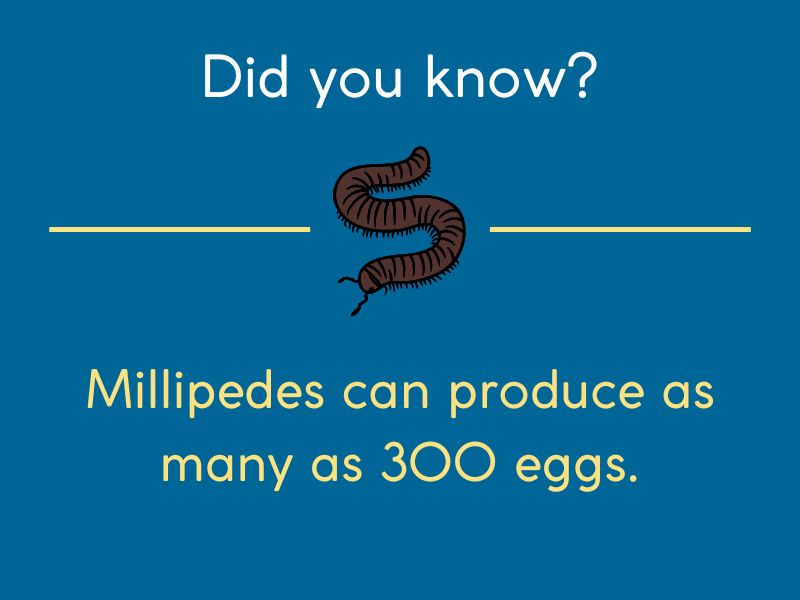
What Is the Difference Between Centipedes and Millipedes?
Although similar, centipedes are not the same animals as millipedes. They differ in appearance, feeding habits, and amount of movement.
You may be wondering what do centipedes and millipedes look like? Centipedes have a flatter body while millipedes are rounder.
This is not the only difference between the two because centipedes also have only one leg per segment on the body compared with millipedes which have two legs per segment. The feeding habits and even how active these inverts are is also different.
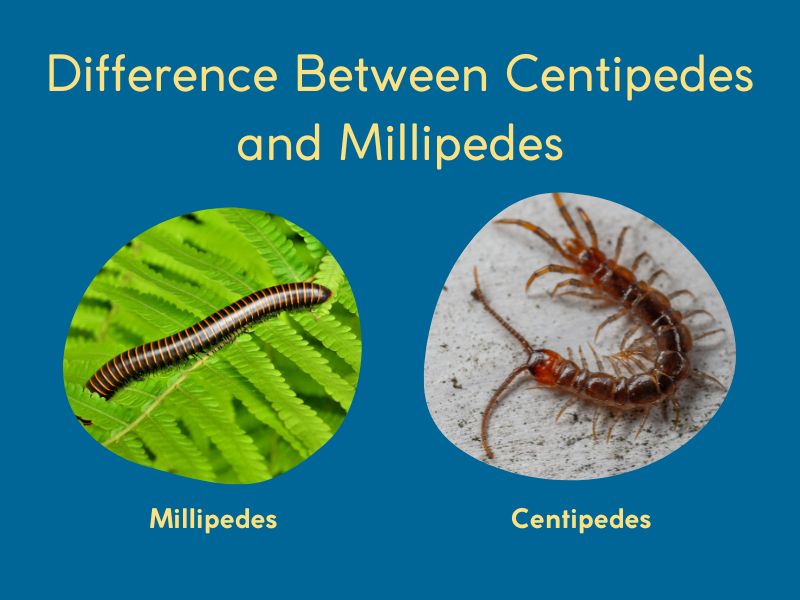
Biology of Centipedes
Centipedes are predators that can run quite fast to catch prey and escape from danger. Centipedes are predacious, feeding on other small insects and arthropods; they also move quite fast and readily hide. They are commonly found when you pick up a rock or disturb leaf litter. While most centipedes cannot hurt you there are a few species that can bite if they feel threatened.
Centipedes either lay eggs or bear live young depending on the species. If they lay eggs these are deposited in the soil during the warm season. The babies hatch from the eggs and look like the adults but are very small. In time they molt and grow until they reach adult size. They can live up to 6 years.
Biology of Millipedes
Millipedes feed on plant matter, decaying material, and on organic matter found in the soil and under leaf litter. These inverts are scavengers and do not actively hunt so they do not move fast like centipedes and instead will curl up into a ball when threatened.
Millipedes do lay eggs. They can produce as many as 300 eggs which hatch in a few weeks into tiny millipedes that eventually molt into the adult form. The millipedes can live a few years.
While millipedes do not bite, they do produce a chemical that is toxic but only serves as an irritant when it comes into contact with human skin.
Signs of a Centipede or Millipede in the House
Unlike other arthropods like cockroaches, there will not be many signs that you have a centipede or millipede in the house. Usually, the only sign of one of these arthropods is seeing the actual animal inside.
There have been stories of centipedes and millipedes in Singapore, including a story of a lady who was bitten by a centipede. They, therefore, can be a nuisance in the home, along with millipedes. In general, these insects are really just a nuisance and not harmful unless they come into close contact with people or pets in the home.

How to Prevent Centipedes and Millipedes From Entering Your Home
It is very unlikely that you will have a centipede and millipede infestation in your home because they really do not normally try to enter a house or dwelling. However, during dry conditions it is possible that these arthropods will find themselves inside a house because they look for moisture. A change in weather is one of many possible causes of centipedes and millipedes entering the home.
Centipedes and millipedes cannot survive in very dry conditions and will actively seek out moist warm conditions; this can mean that they crawl inside through gaps or small openings near the base of your house.
We have listed some centipede and millipede prevention tips below to help you prevent centipedes and millipedes from entering your home.
- Check weatherstripping and caulking to make sure these have not deteriorated leaving spaces through which pests can enter.
- Seal any gaps or cracks that could allow arthropods to enter your home.
- Fix any leaking plumbing fixtures including pipes and faucets that may be dripping.
- Use a dehumidifier or other means to dry out your house.
- Remove any leaf litter that may be right next to the house.
Pro Tip: It's best to get advice from pest control professionals if you are concerned about centipedes or millipedes in the house and how to treat them effectively.
How to Get Rid of Centipedes?
You may wonder how you can rid yourself of centipedes in your house. The first step is to make sure you do not have any damp areas around. Fixing any leaking pipes or faucets can help. Dry out areas of the house where there is dampness.
You can also inspect and directly remove any centipedes that you come across but remember that some species do bite so perhaps use tweezers to pick up any you find. Control measures can include using pesticides but this can be tricky if you have pets and small children in the house, and is best left to a professional pest control treatment.

Pest Problem? Let Us Help.
We offer fast and effective precision treatments to eliminate pests while ensuring a safe environment for your home or business.
How to Get Rid of Millipedes?
You can use a similar approach to getting rid of millipedes. Removing moisture and checking under boxes and in dark corners can help you find millipedes. Millipedes do not move fast so they are fairly easy to catch and remove. However, they do secrete substances that can be irritating so perhaps wear gloves if you choose to physically pick up and remove these arthropods yourself.
Consulting a pest control specialist is a good idea if you are concerned about centipedes or millipedes in the house. They will also be able to advise you on which pesticides to use or if fumigation is needed.
How to prevent centipedes and how to prevent millipedes from entering the home means making sure that conditions are not favourable for them. Even though millipedes and centipedes are mainly just a nuisance and not usually major pests, the presence of these arthropods can mean that other worse pests are also able to enter your home.
Frequently Asked Questions
Centipedes’ bites can be quite painful for people as they use their venom as a defense mechanism. Although typically not fatal or dangerous, their bites can hurt, especially when centipedes are large.
Millipedes are not venomous or poisonous, although their defensive spray contains fluids that may cause allergic reactions in some individuals.
Unlike centipedes, millipedes do not bite or sting. They usually produce a fluid that keeps the predators away.


